There are a couple of determining factors in what makes for a top 50 quarterback. Those qualifying attributes include career statistics, efficiency, longevity, durability, and of course, Super Bowl wins. From notorious names of yesteryear including Joe Namath and Johnny Unitas to today's most cherished quarterback personalities like Peyton Manning and Brett Favre, we've curated a list of the top fifty quarterbacks to ever take the field. Check out the list for yourself below, do you agree with these rankings?
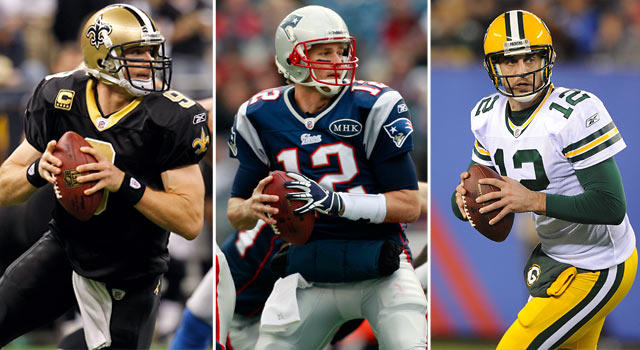
The quarterback position is easily the most important position on the field when it comes to football. No disrespect to the offensive linemen that keep the quarterback protected, but the true director of an offense has always been the quarterback. From reading defenses at the line, calling audibles to help your team progress, and placing the ball in the right place for their receivers, every game lies on their shoulders.
Throughout the past three decades, we've seen an increase in precision, athletism, and durability at the quarterback position. The modern quarterback is more versatile than ever and willing to deliver the ball through the air without thinking twice. However, while the reward is high to be praised as one of the best quarterbacks in the NFL, the risk is just as prevalent.
If it wasn't for the death of his father, at the tender age of seven, and his step-father's encouragement to play sports, Jim Hart might have never pursued a career in professional football. However, that one piece of fatherly influence led Hart to become a three-sport athlete in high school and he even lettered in basketball a total of three times. After becoming known for prowess on the football field, Hart was granted a scholarship to football for the Southern Illinois University Salukis where he played from 1963 to 1965.

Unfortunately, after going unnoticed throughout his collegiate stint at Southern Illinois and declaring himself into the 1966 NFL Draft, Jim Hart went undrafted. Luckily, his former coach Don Shroyer sent him an invite to try out for the St. Louis Cardinals that same year which led to Hart getting a backup quarterback position behind Terry Nofsinger. The following year, in 1967, Hart earned the starting quarterback position where he would start sixteen years out of the seventeen seasons he played with the team. While he did lead the team to multiple ten-plus win seasons, Hart was never able to get the team to the Super Bowl. The 4x Pro Bowler also developed a knack for throwing interceptions throwing a total of 247 in comparison to the 209 touchdowns he threw throughout his eighteen-season NFL career. Hart also threw an NFL record five interceptions in the1977 Pro Bowl. Eventually, Hart would call it quits after becoming a backup quarterback for the Washington Redskins for a single season in 1984.
Longevity and finding his way bouncing around the league contributed to the legacy that Ron Jaworski left behind as one of the better quarterbacks the NFL has seen to date. While Jaworski may not have ever achieved the top accomplishment a pro-football player could achieve by earning the Lombardi Trophy, he did have a lengthy playing career which later led to broadcasting and the ownership of an arena football team. Growing up a three-sport athlete, Jaworski declined a contract offer from the St. Louis Cardinals in order to play collegiate football at Youngstown State University where he was selected to play in the Senior Bowl his final season with the Penguins.

In the 1973 NFL Draft, Jaworski was selected 37th overall in the second round by the Los Angeles Rams where he would end up playing third-string quarterback behind John Hadl and James Harris. In 1975, both quarterbacks suffered injuries that led to Jaworski becoming the starting quarterback and helped the Rams win a playoff game before he made his way to the Philadelphia Eagles in 1977 where his most prominent playing years were spent. 1980, was Jaworski's best year as a quarterback, leading the Eagles to an 11-1 record, earning Pro Bowl honors, the NFC Player of the Year Award, Bell Bert Award, and a trip to Super Bowl XV. Unfortunately, the Eagles lost to the Oakland Raiders, 27-10 and years later Jaworski lost his starting job at quarterback. Throughout his seventeen-season NFL career, Jaworski also played for the Miami Dolphins and Kansas City Chiefs until his retirement in 1990.
Archie Manning, the son of Buddy Manning, and the father of, Peyton and Eli Manning the best brother quarterback duo in NFL history, is next up on the list. While he might not be as revered for his professional football career as his sons are, Archie did have a promising career in baseball after being drafted a total of four times. The first time Manning was drafted it was by the Atlanta Braves in 1967, he would then go on to be drafted twice by the Chicago White Sox, and lastly by the Kansas City Royals in 1971, the same year he was drafted into the NFL. Manning attended the University of Mississippi where he started at the quarterback for three consecutive seasons. Manning was named SEC Player of the Year and First-Team All-American for the 1969 NCAA Football season.

After a successful career with the Ole Miss Rebels, Archie Manning would go on to be selected 2nd overall in the 1971 NFL Draft by the New Orleans Saints where he would play the first ten seasons of his NFL career. Unfortunately, Manning and the Saints would suffer nine losing seasons out of those ten, but become one of the most respected pass throwers in the league amongst his peers. In 1978 and 1979, Manning was selected for the Pro Bowl and ended his career playing seasons with the Houston Oilers and the Minnesota Vikings. With a win-loss record of 35-101-3 and a career passer rating of 67.1, Manning as an individual was a better football player than any team he was a part of.
Hailing from Cedar Rapids, Iowa, Trent Green has carved out a legacy worth recognition from the quarterback position. His fifteen-season NFL career did not come without adversity, it took Green time to become a trustworthy, reliable first-string quarterback in the league and he earned the recognition he now is receiving as one of the better quarterbacks in pro-football history. Green played his collegiate football at Indiana University Bloomington from 1989 to 1992. In his four seasons as a Hoosier, Green led the team to the 1991 Copper Bowl and threw for 5,400 yards and 23 touchdowns.

After an impressive stint in Indiana, Trent Green was selected 222nd overall in the eighth round of the 1993 NFL Draft by the San Diego Chargers where he was placed as a backup and didn't see a single snap from center. In 1994, Green took his talents to the Canadian Football League where he played for the British Columbia Lions for a single season. In 1995, Green made his way back to the NFL as a member of the Washington Redskins and again saw no playing time until 1998. In 199, Green signed a deal with the St. Louis Rams where he was slated to be a starter, but a season-ending knee injury took him out and Kurt Warner led the Rams to a Super Bowl (XXXIV) victory in 2000. Green's most prominent years came from his tenure as a member of the Kansas City Chiefs where he was a 2x Pro Bowler (2003, 2005). After a single season with the Miami Dolphins (2007) and an additional season back with the Rams, Green retired in 2010. He currently holds the tied NFL record for the longest touchdown pass at 99 yards.
Vinny Testaverde never really excelled at one particular skill set to help take his teams to the next level, but his longevity in the game has allowed him to become one of the most notable quarterbacks of all-time. With twenty-one seasons of pro-football under Testaverde's belt, his durability is a testament to his legacy as one of the greats to ever take a snap underneath center. Hailing from Brooklyn, New York, Vinny Testaverde played four years of college football at the University of Miami from 1983-1986. During his tenure with the Hurricanes, Testaverde became one of the institution's allt-ime leading touchdown passers with 48 and won the Heisman Trophy as a senior.

Vinny Testaverde was drafted 1st overall in the 1987 NFL Draft by the Tampa Bay Buccaneers where he would play the first six seasons of his lengthy NFL career. He would also go on to play for several other NFL franchises including the Cleveland Browns, Baltimore Ravens, New York Jets (2x), Dallas Cowboys, New England Patriots, and Carolina Panthers before calling it quits in 2008. His best play as a starter came in his first season with the Jets in 1998 when he threw 29 touchdowns with a passer rating of 101.6. Unfortunately, most of the teams he played ended up with losing records. Testaverde's 123 losses is the most in NFL history by a starting quarterback, but upon his retirement he held top ten records for career passing yardage (46,233), career touchdown passes (275), and completions (3,787).
Mark Brunell was one of those quarterbacks that was so extremely dominant as an adolescent and during his collegiate football career, he might have underperformed to the masses expectations throughout his official professional football career. His ability to find work around the league for a total of nineteen seasons might also be the cause of his inflated numbers. While Brunell was mediocre at times, he was a steady option at the quarterback position for many clubs during his tenure in the NFL. Brunell attended the University of Washington from 1989 to 1992 where he would have to battle for starting quarterback rights his entire four-season tenure with the Huskies. The 6'1 quarterback would go on to lead the Huskies to a National Championship in 2001 and be crowned the Rose Bowl MVP.

After his rollercoaster college career came to an end, Mark Brunell went on to be drafted 118th overall in the fifth round of the 1993 NFL Draft by the Green Bay Packers where he would only play a total of two seasons and not take a single snap under center during his first season with the team. However, Brunell's most prominent years during his career would happen to take place in Jacksonville (1995-2003), where he would become a 3x Pro Bowler and lead the team to the playoffs four times out the nine seasons he played with the Jaguars. Brunell would eventually pick up a ring as a backup quarterback in New Orleans after Brees led the Saints to a victory over the Indianapolis Colts in Super Bowl XLIV. Brunell would see short stints with the Washington Redskins and New York Jets before officially retiring in 2012.
Christian Adolf Jurgensen III better known as, Sonny Jurgensen, might have played in an era of football where quarterbacks were extremely reserved, but Jurgensen was willing to take risks through the air while he was on the field. During his tenure in the NFL, a lot of controversy surrounded his style of play for refusing to play ball-controlled conservative football. His unwillingness to conform split the city of Washington DC in half on whether Jurgensen or the team's second option should be the starting quarterback for the Redskins back in the early 1970s. Jurgensen attended Duke University from 1954 to 1956 and had an instant impact on the field as a defensive back. In his initial year with the team, Jurgensen broke a school record, nabbing an interception in four consecutive games. The following year, Sonny took over as starting quarterback and led the Blue Devils to an ACC co-championship. Despite starting out hot, Jurgensen had an abysmal final year at Duke, finishing the season 5-4-1.

Sonny Jurgensen would go on to be drafted 43rd overall in the fourth round of the 1957 NFL Draft by the Philadelphia Eagles where he would play seven seasons out of the eighteen seasons of his total NFL career. Sonny would go on to win an NFL Championship with the Eagles as a backup in 1960 but threw for an NFL record 3,723 yards and an NFL record-tying 32 touchdowns the following year as the team's starting quarterback. At the time, this was unheard of and Jurgensen began to revolutionize the game as a precision passer throughout his entire NFL career. In 1964, 5x Pro Bowler signed a deal with the Washington Redskins where he would play for the next decade before retiring. Throughout Jurgensen's nearly two-decade career, he would lead the league in passing yards five times as well as touchdowns twice.
Michael Vick single-handedly revolutionized the quarterback position. We've never witnessed a quarterback that was as agile, athletic, and able to deliver the ball through the air as precise as Michael Vick was able to do during his prime years in the NFL. If Vick were to bypass his legal hiccups, he could have been a quarterback rated considerably higher on this list. After a childhood filled with turmoil growing up in Newport News, Virginia, Vick took his talents to Virginia Tech where he would play two seasons of football from 1999-2000 after being redshirted in 1998. Vick led the NCAA in passer rating in 1999 (180.4), a record as a freshman quarterback, and led the Hokies to a victory in the 2000 Gator Bowl where he was named MVP.

In 2001, Michael Vick was picked first overall in the NFL Draft by the Atlanta Falcons where he would play six seasons out of his thirteen-season NFL career. In Atlanta, Vick would become known as the greatest rushing quarterback to take the field with a 40-yard dash time of just 4.33 seconds. He would lead the Falcons to two playoff berths (2002, 2004) before being suspended for the 2007 and 2008 seasons for alleged convictions of animal abuse. After returning from suspension, Vick suited up for the Philadelphia Eagles for five seasons leading them to two playoff runs (2009, 2010) before becoming an NFL journeyman, playing for both the New York Jets and Pittsburgh Steelers before retiring in 2016.
If there is one personality characteristic that stands out when it comes to Matt Ryan it's definitely his tenacity. No matter what his team is going through or what he may be handing on a personal level, he keeps his head held high and speaks well of everyone around him. His durability and consistency have led to a spot on our top fifty quarterbacks of all-time list. The 6'4 quarterback from Philadelphia, Pennsylvania played his collegiate ball at Boston College from 2004 to 2007 after being redshirted in 2003. In his final season with the Eagles, Ryan was presented with the Johnny Unitas Golden Arm Award, the Manning Award, and was named ACC Player of the Year.

After outperforming many of his peers at the college level, Matt Ryan was selected 3rd overall by the Atlanta Falcons in the 2008 NFL Draft where he has played his entire twelve-seasons NFL career. After being named starting quarterback prior to ever throwing a pass as a pro-quarterback he was named the starter for the Falcons and did not disappoint. Ryan was named Offensive Rookie of the Year and led the team to the playoffs that same year. Since then, Ryan has led the Falcons to the playoffs an additional five times including a trip to the Super Bowl (LI) during the 2016 season. In 2016, Matt Ryan was named the NFL MVP, the Offensive Player of the Year, and led the league in passer rating (117.1).
Historically, the Cleveland Browns haven't had the best of luck when it comes to the quarterback position. However, Bernie Kosar was able to be that beacon of light for the franchise and its fans to draft well at the position. Kosar was known for functioning well in pass-first offenses and was highly efficient when it came to getting the ball to his receivers in clutch moments. Bernie Kosar was so clutch that he started all twelve games at the University of Miami in 1983 after being redshirted in 1982. Kosar led the Hurricanes to their first-ever national championship in 1983 where was MVP of the Orange Bowl. Kosar also fell victim to Doug Flutie's 'Hail Flutie' pass and a loss in the 1985 Fiesta Bowl.
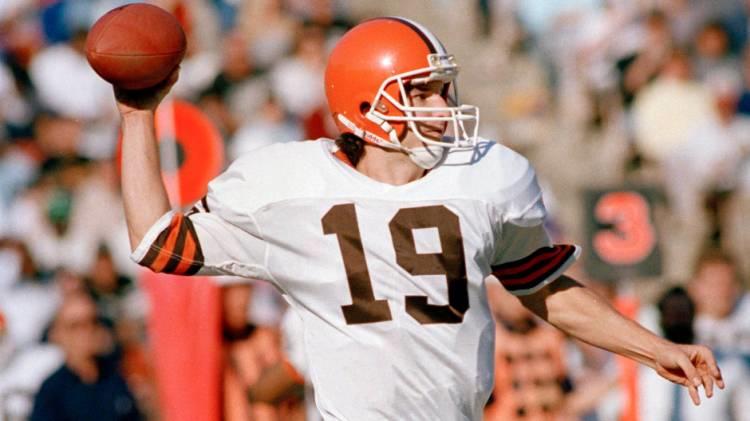
After a successful stint in college and some eligibility controversy, Kosar was drafted 1st overall in the 1985 Supplemental NFL Draft by the Cleveland Browns where he would spend the majority of his NFL career. During his tenure with the Browns, Kosar would rack up two Pro Bowl selections in 1987 and 1989 where he would lead the Browns to back-to-back AFC championship games in 1986 and 1987. Unfortunately, after suffering multiple injuries, Kosar and the Browns parted ways and Kosar would sign a contract with the Dallas Cowboys where he would earn a Super Bowl ring as a backup. Kosar played his final three NFL seasons as a member of the Miami Dolphins and ended his career holding the record for most consecutive completed passes without an interception until it was broken by Tom Brady in December 2010.
While Boomer Esiason might have one of the most ridiculous haircuts on this list (look it up), he definitely was an offensive leader worth keeping a close eye on as a defensive coordinator. And while Esiason might have also played for some pretty lackluster team's during his decade-plus tenure in the NFL, he's proven why he deserves to be on our top fifty quarterback list of all-time with his size and ability to maneuver outside of the pocket and pick up yardage with his feet. The 6'5 quarterback hailing from East Islip, New York played his collegiate football at the only institution willing to offer him a scholarship, the University of Maryland. While at Maryland, Boomer broke seventeen different football records, was named All-American in his final two seasons (1982 and 1983), and helped the Terrapins secure an ACC Championship over the North Carolina Tar Heels in his final home game.

Despite his impressive play at the University of Maryland, Boomer Esiason was picked 38th overall in the 1984 NFL Draft by the Cincinnati Bengals where he played nine seasons out his fourteen-season NFL career. As the starting quarterback of the Bengals, Esiason led the Ohio-based football franchise to Super Bowl XXIII but stood no chance against Joe Montana and the red hot San Francisco 49ers ultimately losing 20-16. Boomer's AFC Player of the Year Award (1988), NFL MVP Award (1988), and three out of his four Pro Bowl nominations all came during his tenure with the Bengals. In 1993, Esiason was traded to the New York Jets where he played from 1993 to 1995 and signed additional contracts with the Arizona Cardinals and his former Bengals team before retiring in 1997.
Standing at 6'4 and weighing at 240lbs, Daunte Culpepper was one of those large quarterbacks that was athletically nimble and could take a hit. Whether on the ground or through the air, Culpepper delivered results during the prime years of his NFL career. Daunte Culpepper's mother, Barbara Henderson was serving a prison sentence during her pregnancy and adopted and raised by Emma Lewis Culpepper who worked at the same correctional facility, Daunte's mother was being held at. Throughout his sports career, Culpepper excelled at multiple sports and was even drafted 26th overall in the 1995 MLB Draft by the New York Yankees. Culpepper refused to sign a contract with the Yankees and took his talents to the University of Central Florida where he would play from 1995-1998.

After virtually rewriting UCF's quarterback record books, Daunte Culpepper was selected 11th overall in the 1999 NFL Draft by the Minnesota Vikings where he would play seven seasons out of hi eleven-season NFL career. The 3x Pro Bowl selectee's best season came in 2004 when he contributed to a total yardage of 5,123, the most by a quarterback in a single season in NFL history. Unfortunately, in 2005, Culpepper would suffer a knee injury that damaged his ACL, MCL, and PCL that would derail his professional football for the remainder of his days. From 2006 to 2009, Culpepper would suit up for the Miami Dolphins, Oakland Raiders, and Detriot Lions before taking his talents to the United Football League where he would play a single season for the Sacramento Mountain Lions before his official retirement from the game.
Standing at 6'5 and weighing 220lbs, hailing from Zachary, Louisana, Doug Williams is known for breaking many of NFL records and not just statistically but socially. Before even stepping onto a professional football field, Williams was known for his studious nature, perfect passing mechanics, poise, and his insanely strong arm. While attending Grambling State University, Williams led the Tigers to a 36-7 record as a four-starter, winning three South Western Conference Championship, leading the NCAA in several statistical categories, and graduating with a bachelor's degree in education. Despite all of Williams' success, only one NFL scout came to see him prior to Williams deciding to declare himself into the NFL Draft.

In the 1978 NFL Draft, Williams was selected 17th overall by the Tampa Bay Buccaneers. Prior to Williams' arrival, the Bucs had won just two games in two seasons since the franchises beginning. Williams led the Bucs to three postseasons in five seasons, however, after a contract dispute, Williams took his talents to the USFL where he played two seasons with the Oklahoma/Arizona Outlaws. In 1986, Doug Williams returned to the NFL with the Washington Redskins where he would make history becoming the first Black quarterback to play in the Super Bowl (XXII), the first Black quarterback to win the Super Bowl, and the only Black quarterback to be named Super Bowl MVP to this day. While Williams did accomplish a lot as an African-American quarterback, he also threw for a record 340 yards in the Super Bowl, became the first player to throw for four touchdowns in a half in a Super Bowl, and the only player to throw for four touchdowns in a quarter in a Super Bowl.
While Eli Manning's career may be on the decline, he has been able to put together one of the best resumes from the quarterback position we've seen in this current generation. As of right now, he might be a backup to the newcomer, Daniel Jones, but Eli is currently ranked amongst the top ten quarterbacks in history in passing touchdowns (362) and passing yards (56,537). The son of famed former NFL quarterback, Archie Manning, played his collegiate football at the University of Mississippi from 2000 to 2003 where he racked up over twenty individual honors including the 2004 SBC Cotton Bowl Classic MVP, 2003 SEC MVP, 2002 Independence Bowl MVP, and more.

After a collegiate Hall of Fame career with the Ole Miss Rebels, Eli Manning was drafted 1st overall in the 2004 NFL Draft by the San Diego Chargers. But after stating publicly he would not suit up for the California-based franchise, he was traded to the New York Giants for 4th overall pick Philip Rivers. Since then, Manning has played his entire sixteen-season NFL career with the Giants leading the team to two Super Bowl championships (XLII, XLVI) both games he was named Super Bowl MVP. Now, the 4x Pro Bowler is looking to regain the juice that allowed him to become one of the NFL's elite quarterbacks, but at 38-years-old is it too late for Eli Manning to add to his legacy?
While Drew Bledsoe's legacy may be foreshadowed by the performance of his then-backup, Tom Brady, his legacy helped rebuild the New England Patriots franchise to what it is today. Bledsoe was a high-volume quarterback that wasn't afraid to let the ball fly on any defense the NFL had to offer. During his three-year tenure at Washington State University, Bledsoe shattered a multitude of records including most passing yards in a single game (476), most pass completions in a single season (241), and single-season passing yards (3,946). In 1992, Bledsoe led the Cougars to a 31-28 Copper Bowl victory over the Utah Utes and won the Pac-10 Offensive Player of the Year Award.

In the 1993 NFL Draft, Drew Bledsoe was selected 1st overall by the New England Patriots where he would play nine seasons out of his fourteen-season NFL career. While a member of the Patriots, Bledsoe became the youngest quarterback to surpass 10,000 and 20,000 passing yards. Bledsoe also holds the record for most completions in a game with 45. The 4x Pro Bowler did win a ring in his final season with the Patriots in Super Bowl XXXVI. Bledsoe would go to play three seasons with the Buffalo Bills from 2002 to 2004 and the Dallas Cowboys from 2005 to 2006. Injuries and some lackluster performances helped Bledsoe choose retirement in April 2007, but he will forever be known as a legend in New England.
Philip Rivers is one of the most intense quarterbacks of this current generation. Whether he's on the field or the sidelines in the midst of the game, Rivers displays a fiery passion unlike any other quarterback playing today. His unorthodox sidearm throw and willingness to go for the deep bomb have contributed to his success in the NFL. The 6'5 quarterback, hailing from Decatur, Alabama played his collegiate ball at North Carolina State University from 2000 to 2003. In four seasons with the NC State Wolfpack, Rivers threw for a total of 13,484 yards and racked up 95 touchdowns tying for eighth in the school's history.

Philip Rivers' NFL career began with some controversy that resulted in him being picked 4th overall by the New York Giants in the 2004 NFL Draft and traded to the then-San Diego Chargers for Eli Manning who refused to suit up for the Chargers. Since the trade, Rivers has played his entire sixteen-season NFL career with the Chargers. After getting the starting quarterback position in 2006, Rivers has led the Chargers to six NFL postseasons. While the 8x NFL Pro Bowl selectee has led the Chargers to multiple playoff berths and thrown for over 55,000 yards, Rivers has yet to lead the team to Super Bowl keeping him from a higher ranking on our list.
Hailing from Lawernce, Kansas, John Willard Hadl might have been somewhat undersized at quarterback standing at 6'1, but he's been able to create quite the legacy for himself as an elite passer and athlete in pro-football. Prior to his AFL/NFL career, John Hadl played his collegiate football in his home state at the University of Kansas where he not only played quarterback, he played halfback and defense back as well. In 1960, Hadl was named All-American for his performance as a running back and All-American the following year for his performance as a quarterback. Hadl led the Jayhawks to victory in the Bluebonnet Bowl in 1961 and won MVP in the College All-Star Game that same year.

John Hadl was selected 10th overall in the 1962 NFL Draft and 24th overall in the third round of the 1962 AFL Draft by the San Diego Chargers where he played from 1962 to 1972. In 1963, Hadl helped lead the Chargers to an AFL Championship and was named a 4x AFL All-Star and 2x NFL Pro Bowler throughout his sixteen-season pro-football career. In 1971, Hadl led the league in passing yards and touchdowns. Prior to retiring in 1978, John Hadl also played for teams like the Los Angeles Rams, Green Bay Packers, and Houston Oilers.
Richard Joseph Gannon is one of those anomalies that is seldom ever seen in the NFL. Most of Rich Gannon's success came at the end of his career after he had failed to find a secure starting job or home as a backup quarterback. This experience would discourage many athletes, but Rich Gannon rose to the occasion and became one of the most respected quarterbacks around the league and during his era in the early 2000s. Gannon attended the University of Delaware from 1984 to 1986 where he began his football career as a punter before switching to quarterback his sophomore season. Despite not being a true quarterback Gannon broke a total of twenty-one school records including passing yards in a single season (5,927) and completions (462) in a single season. In his final year with the Fightin' Blue Hens, Gannon was named Yankee Conference Offensive Player of the Year.

The 6'3, 210lb quarterback was selected 98th overall in the fourth round of the 1987 NFL Draft by the Minnesota Vikings where he played the first six seasons of his NFL career. As a third-string quarterback, Gannon saw limited time on the field until he won the starting job his final three seasons with the Vikings. Rich Gannon also played short stints with the Washington Redskins and Kansas City Chiefs before finding a home with the Oakland Raiders in 1999 where he would become a dominant force in the NFL close to half a decade. Gannon went on to go to four straight Pro Bowls (1999-2002), earn an NFL MVP Award (2002), and lead the Raiders to a Super Bowl (XXXVII) appearance in 2003. While he wasn't able to secure a championship with the Raiders, he's a legend to this very day in Oakland.
First and foremost, rest in power to the young quarterback god, Steve McNair, himself. The majority of football enthusiasts are aware that his life was cut short after his mistress fatally shot in a murder-suicide in July 2009. However, his tragic murder will never deny what he was able to do for the culture and sport of football. The highly-skilled quarterback was extremely dynamic and nimble for his 230lb frame and could match the precision of any quarterback he was going head-to-head with. McNair played his collegiate football at a Historically Black College in Alcorn State University from 1991 to 1994. McNair had the opportunity to ride a full scholarship at the University of Florida as a running back but opted to play for the Alcorn State Braves where he notched 16,823 total career yards and 122 passing touchdowns.

After taking the home the Walter Payton Award as a senior at Alcorn State in 1994, Steve McNair was drafted 3rd overall in the 1995 NFL Draft by the Houston Oilers where he would play eleven out of the thirteen seasons of his pro football career. During his time with the Oilers/Tennessee Titans, McNair would lead the Titans to four playoff berths and one Super Bowl appearance in Super Bowl XXXIV. In 2003, McNair led the league in passer rating and took home the NFL MVP Award for his performance. After being able unable to lead the Titans to the glory land, McNair made his way to the Baltimore Ravens in 2005 where he would play two more seasons and retire in April 2008. The 3x Pro Bowler has since had his jersey number (9) retired by the Titans and will forever be remembered for his impeccable skill on the field.
The famed Kurt Warner went from bagging and stocking groceries to playing in one of the most televised live events in American history. Warner's rise to prominence is another one of those tales of overcoming adversity through hard work and finding oneself in the perfect circumstance to succeed. Kurt Warner attended the University of Northern Iowa but had a less than remarkable career due to being third on the Panthers' quarterback depth chart up until his senior year where he finally got the chance to start. In that single season, Warner performed so well he was named the Gateway Conference Offensive Player of the Year and graduated with a Bachelor's degree in communications.
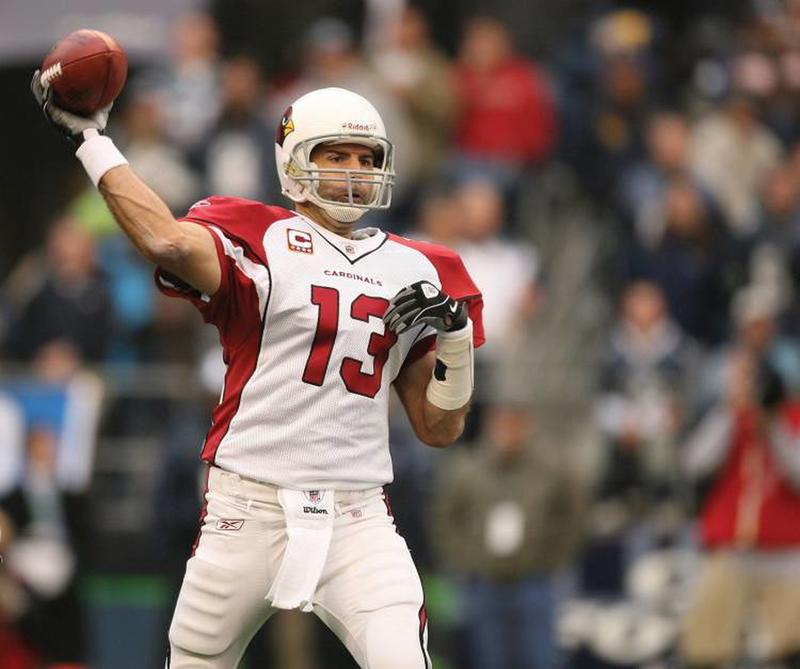
With a less than stellar performance as a Northern Iowa Panthers, Kurt Warner went undrafted in the 1994 NFL Draft but got an opportunity to try out for the Green Bay Packers. Warner was cut from the team and went back to his hometown of Cedar Falls, Iowa to bag groceries for a living. Eventually, Warner would make his way back to the field in the AFL where he played a single season with the Iowa Barnstormers. The following year, Warner participated in the NFL Europe before signing a contract with the St. Louis Rams where he would become a household name. In six seasons with the Rams, Warner became the first undrafted quarterback to lead his team to a Super Bowl victory (XXIV) and win Super Bowl MVP. Warner also holds three out of the five single-game passing yardages in a Super Bowl and led the Arizona Cardinals to their first-ever Super Bowl appearance in Super Bowl XLIII before retiring in January 2010. The now 4x Pro Bowler and Hall of Famer is considered the best-undrafted football player of all-time.
Joe Theismann's leg snapping like a twig is usually the first memory for many OG football fanatics when his name is brought up. What many forget about Theismann was his willingness to take risks in the pocket, get yards himself on foot, and the rocket he had for an arm. The three-sport high school athlete decided to take his talents to the University of Notre Dame to play his collegiate football. In his sophomore year, he earned the starting quarterback job and instantaneously became a force compiling an overall record of 20-3-2. In 1970, he helped the Fightin' Irish secure a Cotton Bowl Classic victory over Texas and set school records for completions in a single game (33), passing yards in a single season (2,429), passing yards in a single game (526), and touchdowns in a single season (16).
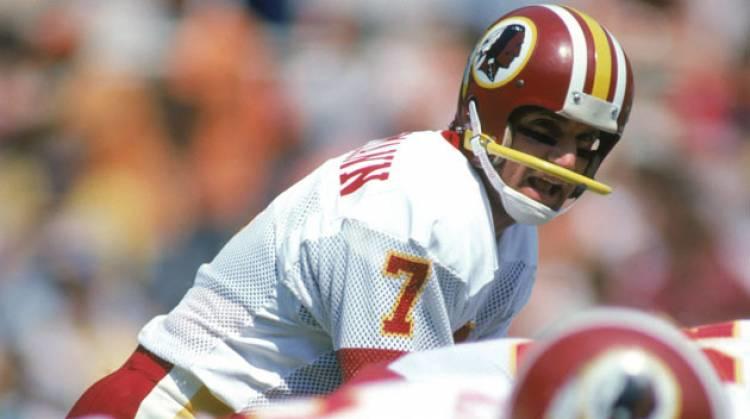
After finishing second in Heisman Trophy voting behind Jim Plunkett, Theismann was drafted 99th overall in the fourth round of the 1971 NFL Draft by the Miami Dolphins and drafted in the 39th round of the 1971 MLB Draft by the Minnesota Twins. After being unable to come to contract terms with the Dolphins, Theismann took his talents to the CFL where he played for the Toronto Argonauts where he was named an all-star in two out of the three seasons he played with the league. In 1974, Theismann signed a contract with the Washington Redskins where he would play his entire twelve-season NFL career. In 1982, Theismann would lead the Redskins to their first championship in 40 years after defeating the Miami Dolphins in Super Bowl XVII. The following season, Theismann led the Redskins to another Super Bowl appearance but fell short to the Los Angeles Raiders. Joe Theismann's prosperous NFL career was cut short after a lower right leg hit by Lawernce Taylor shattered the fibula and tibia. It wasn't a pretty sight, but the 1x NFL MVP (1983) left a legacy behind worthy of compliment.
Jim Plunkett is another one of those quarterbacks who developed into a great quarterback with age. While many teams doubted his ability, it took one west coast franchise to turn him into a 2x Super Bowl winner. From an early age, Plunkett's odds were stacked against him from living a prosperous life. Growing up poor in New Mexico, Plunkett was forced to work as a grocery bagger, gas station janitor, newspaper delivery boy while still in elementary school. Fortunately, his skill on the football field led him to Standford University where he would become a Stanford Cardinal legend. After struggling with a thyroid issue and being moved around the depth chart, Plunkett led the Cardinal to their first Rose Bowl appearance since 1952. After beating the Ohio Buckeyes 27-17, Plunkett was named the 1970 Heisman Trophy winner.
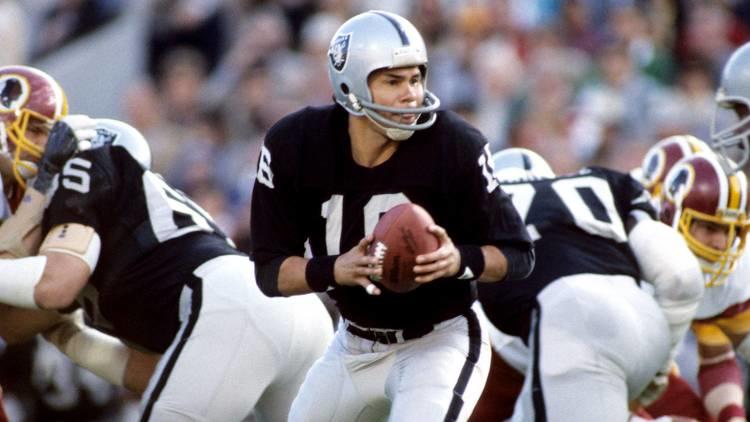
The following year, Jim Plunkett was drafted 1st overall in the 1971 NFL Draft by the New England Patriots, becoming the first athlete of Hispanic heritage to be picked first overall in the NFL Draft. After some initial success and a gradual decline in play, Plunkett was traded to the San Francisco 49ers in 1976. After not being able to adjust to his new scenery, Plunkett made his way to the Oakland Raiders in 1978 where he would play his final eight seasons and become a Raider legend. In 1980, Plunkett won Comeback Player of the Year and guided the Raiders to victory in Super Bowl XV and win Super Bowl MVP. Three years later, Plunkett would lead the Raiders to another Super Bowl win in Super Bowl XVIII. Plunkett is the only quarterback to win two championships with the same franchise in two different cities (Oakland and Los Angeles) and is the only quarterback with two Super Bowl titles not to make the Pro Football Hall of Fame. Plunkett's eligibility for the Hall of Fame is a discussion that needs to be had, the sooner the better.
Not only has Ben Roethlisberger stood the test of time, but he's also proven himself as one of the better performing quarterbacks of this current generation. While he might be currently injured and unable to perform for the 2019-2020 NFL season, he's a reliable quarterback, but his character comes into question in regards to his off the field curricular activities. With that said, Roethlisberger attended Miami University from 2000 to 2003. After being redshirted his freshman year, the 6'5, 240lb quarterback would go on to start at quarterback for the Redhawks and shatter twenty-one school records including two NCAA records for most games in a single season with over 200 yards in passing (14) and most consecutive games with over 200 yards in passing (14). His senior year, Roethlisberger was named the Mid-American Conference MVP.
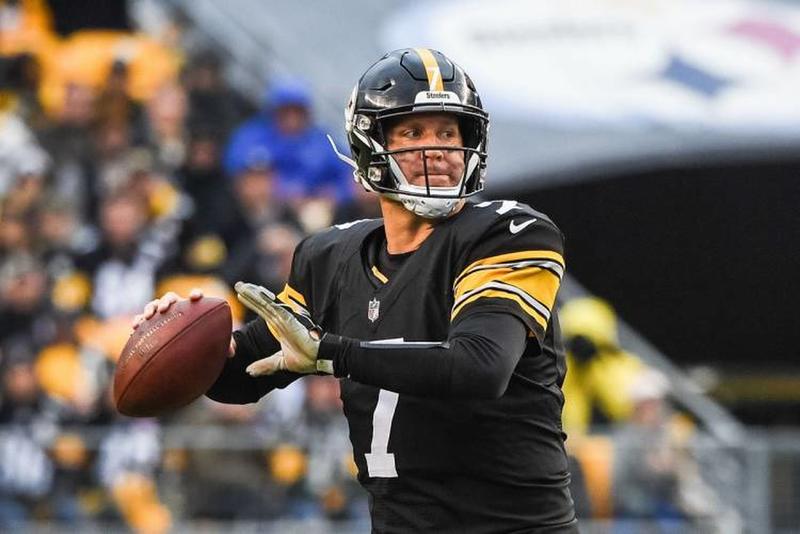
After an impressive showing at Miami University, Ben Roethlisberger was drafted 11th overall in the 2004 NFL Draft by the Pittsburgh Steelers where he's played his entire sixteen-season career. After winning Offensive Rookie of the Year his first season as a Steeler, Roethlisberger in his second season with the club led the Steelers to a championship defeating the Seattle Seahawks 21-10 in Super Bowl XL. Three years later, he led the Pennsylvania-based team to a second Super Bowl victory in Super Bowl XLIII. Since then, the 6x Pro Bowler has led the Steelers to a third Super Bowl and racked up two passing leader privileges for the years 2014 and 2018.
Many might recognize the name and face of Phil Simms for his color commentary as a CBS sportscaster. What many forget is that Simms had one hell of a football career that lasted an entire decade and a half. While he wasn't known for exactly blowing his competition out of the water with insane stats, Simms would make the right decisions to help his team get in the perfect positions to win football games. Simms played his college football at the Division II Morehead State University. The Morehead State Eagles were known for their ball control offense that didn't necessarily allow Simms to thrive in the pocket or take many risks delivering the ball through the air. Throughout his entire college career, the Eagles failed to make the postseason.
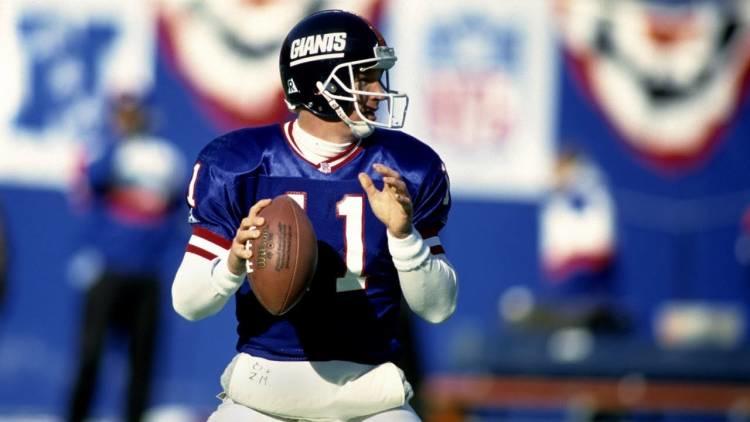
Despite a rather unfulfilling college football career, Phil Simms was drafted 7th overall in the 1979 NFL Draft by the New York Giants where he would play his entire professional football career. As a rookie, Simms won his first five games as a starting quarterback. Unfortunately, the first seven seasons of his NFL career was plagued with injuries and mediocre play which made Giants' fans and the organization question their decision to draft the QB so high. Fortunately, in 1987 things turned around for Simms and the Giants as he held them to a 39-20 victory over the Denver Broncos in Super Bowl XXI. In that game, Simms won Super Bowl MVP honors after throwing 22 completions out of 25 (88%) making his performance the highest completion percentage in a Super Bowl to date. Simms led the Giants to another championship in Super Bowl XXV before retiring after the 1993 NFL season.
Some might be questioning Donovan McNabb's placement on the list, but it is undeniable how much of an impact he had on games throughout his career. McNabb was known for single-handedly shifting the momentum of a game by flawlessly delivering a dime down the field or moving his 6'3, 240lb frame like a freight train directly into a linebacker's path. While his success might not have translated to diamonds in the shape of any NFL logos, his peers and those he played against are glad that they don't have to play opposite of him anymore. McNabb took his talents to Syracuse University where he played both football and basketball. And while the school is known for its elite basketball program, McNabb chose to represent the Syracuse Orangemen to prove that he was a worthy pocket-passer. McNabb proved just that winning the Big East Offensive Player of the Year Award from 1996-98 and leading the Orange to an Orange Bowl appearance his senior year.
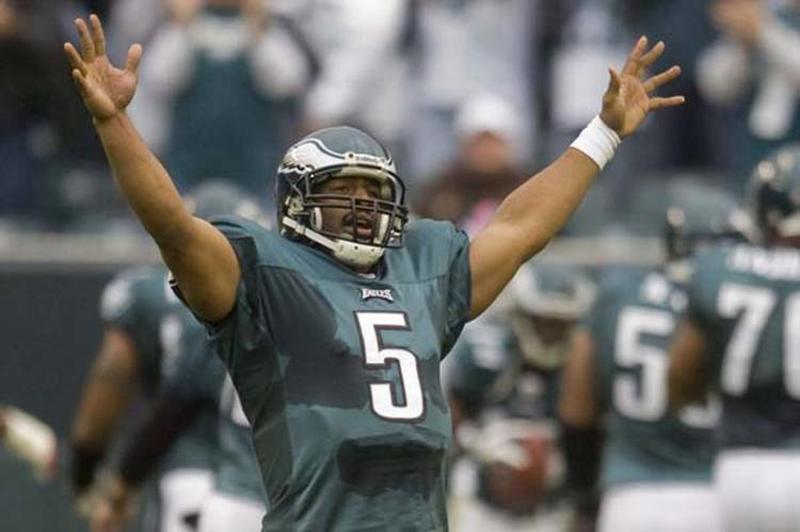
After being so dominant on a collegiate level, Donovan McNabb was drafted 2nd overall in the 1999 NFL Draft by the Philadelphia Eagles where he would become a Philly fan-favorite for years to come. In his first full season as a starter, McNabb finished second in NFL MVP voting in 2000 and even led the Eagles to their first playoff berth since 1996. In 2004, McNabb led the Eagles to Super Bowl XXXIX but came up short against Tom Brady and the New England Patriots. Following that season, the 6x Pro Bowler was plagued with injuries from 2005 to 2007. In 2010, McNabb was traded to the Washington Redskins and played a single season with the Minnesota Vikings in 2011 before retiring. With 37,257 career passing yards under his belt and a touchdown to interception ratio of 234-117, Donovan McNabb has proven to be amongst the elite quarterbacks of the modern era of football.
Earlier this year, Jim Kelly announced that he was cancer-free via Instagram. Over the past several years, Kelly has been battling a rare form of cancer that has developed in his upper jaw and his football family has been there to support him each step of the way. As for his pro football career, Jim Kelly led a franchise to a plethora of Super Bowl appearances but quite couldn't seal the deal to have his name etched in stone and lift the Lombardi Trophy over his head. Despite being known as an explosive basketball player in high school, Jim Kelly wanted to pursue a sports career in football. Penn State University, led by coach Joe Paterno, offered Kelly a scholarship to play linebacker for the institution but Kelly decided to take his talents to the University of Miami from 1979 to 1982. Jim Kelly helped the Hurricanes become one of the most dominant Division I football programs, notching 406 completions, 5,233 total yards, and 32 touchdowns in four seasons with Miami.
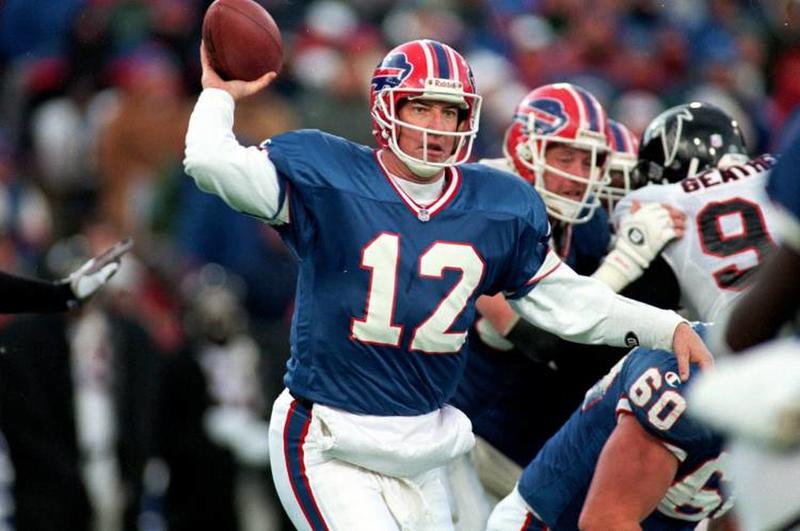
In the 1983 NFL Draft, Jim Kelly was selected 14th overall by the Buffalo Bills but refused to sign with the team due to personal reasons regarding the climate and his faith in the organization. This led to Kelly playing two seasons in the USFL with the Houston Gamblers before finally committing to play with the Buffalo Bills in 1986. In the late 1980s and early '90s, Jim Kelly's ability to run the 'no-huddle' offense made the Buffalo Bills one of the most dangerous teams in all of football. As a starter, Kelly led the Bills to eight playoff appearances, six division titles, and four consecutive Super Bowl appearances in a row (Super Bowl XXV-XXVIII). Unfortunately, the Bills were never able to top their championship competition, but with an overall career record of 101 wins and 59 losses, the Bills have never seen a quarterback talent like his since.
Many might recognize Len Dawson from his notorious photo of him enjoying a soft drink and smoking a cigarette during the halftime of Super Bowl I. But while that image be bizarre in regards to today's societal standards, it was nothing but a regular championship Sunday halftime for those playing and those watching during Dawson's era of pro football. While that image might be ingrained into the heads of many, Dawson was one of the greatest competitors of his era. Hailing from Alliance, Ohio, Dawson played his college ball at Purdue University for three seasons, throwing over 3,000 and leading the Big Ten Conference. Dawson also served as the team's kicker and played on the defensive side of the ball as well.
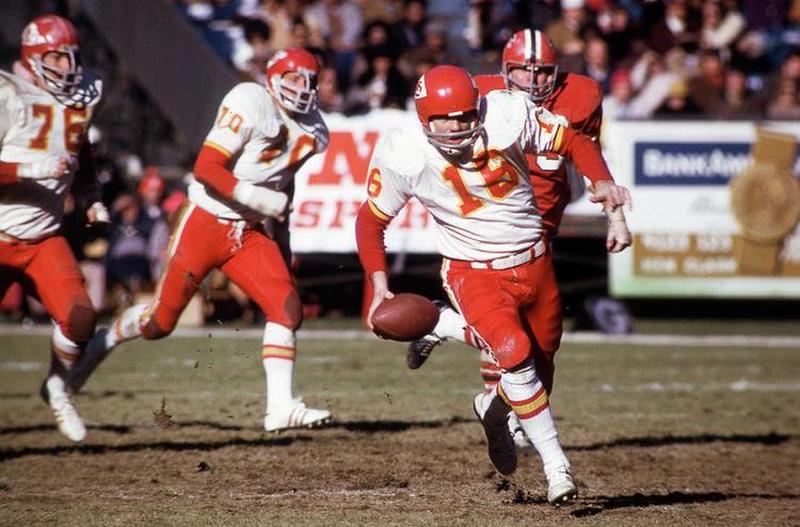
After becoming a dominant force in the Big Ten Conference, Len Dawson was drafted 5th overall in the 1957 NFL Draft by the Pittsburgh Steelers. However, Dawson was unable to become a staple quarterback with the team after the Steelers acquired the more established Bobby Layne in 1958. From 1960 to 1961, Lawson spent a short time with the Cleveland Browns before finding a home with the Dallas Texans/Kansas City Chiefs where he would earn his keep as a Hall of Fame quarterback. In his first season with the team, Dawson would be named AFL MVP after leading the league in touchdowns. Dawson would also lead the Texans/Chiefs to three AFL Championships (1962, 1966, and 1969) while racking up six AFL All-Star honors. Dawson also participated in the first-ever Super Bowl but fell short to the Green Bay Packers. Three years later, Dawson led the Chiefs to a Super Bowl victory in Super Bowl IV over the Minnesota Vikings where he was also named Super Bowl MVP for his performance.
The Miami Dolphins might have surrounded Bob Griese with one of the best-supporting casts of all-time with a stellar defense and running options, but that doesn't take away what he was able to accomplish as a leader of an offense. Without a superior mind taking snaps from behind center, it doesn't matter who you have on your team, some credit deservingly belongs to a quarterback on a successful team and we're here to give Bob Griese his flowers for his efforts on the field. The 6'1 quarterback out of Evansville, Indiana played three different sports out his home state institution of Purdue University. Griese played pitcher on the school's baseball team, guard for the basketball team, as well as quarterback, punter, and kicker for the football team. In 1966, Griese led the Boilermakers to their first-ever Rose Bowl and earned two All-American honors during his collegiate football career.

In the first-ever NFL-AFL merger 1967 Common Draft, Bob Griese was selected 4th overall by the Miami Dolphins where he would play his entire fourteen-season professional football career. Griese had an instant impact as the Dolphins quarterback throwing a touchdown pass on his very first play as a pro to wideout Joe Auer. However, the first three seasons were rough for the up-and-coming Florida-based expansion team. It wasn't until 1971 that Griese would lead the Dolphins to three consecutive Super Bowl appearances. After losing in their initial invitation to the big dance in Super Bowl VI against the Dallas Cowboys, Griese would lead an undefeated 14-0 Dolphins to a Super Bowl victory in Super Bowl VII as well as the following year in Super Bowl VIII. The 6x Pro Bowler also led the league in passing touchdowns in 1977 and was named NFL MVP in 1971 before hanging up his cleats for good after the 1980 season.
Throughout sports history, there might not be a moment that has perfectly encapsulated defeat and an end of an era as Y.A. Tittle's blood-gushing photo of him sitting in his opposition's endzone with a shattered sternum and concussion. While his fall from grace might have been perfectly captured, Y.A. Tittle's legacy as one of the greatest that still stands even after his recent death in October 2017, at the age of 90. Tittle would go on to play running back, defensive back, and quarterback for Louisiana State University from 1944 to 1947. While a member of the LSU Tigers Tittle would break the standing school records for completions (162), passing yards (2,525), and passing touchdowns (23). Tittle was unable to help his Tiger team solidify an SEC Championship after his pants fell causing him to trip during an interception run back on the final play of the game his senior year.
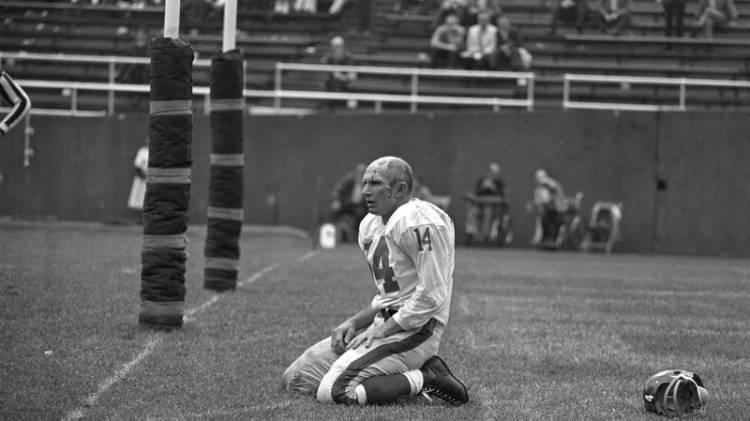
After becoming renowned for his play at the collegiate level, Tittle was drafted 6th overall in the 1948 NFL Draft by the Detriot Lions. However, despite being drafted by the Lions, Tittle began his pro football career as a member of the Baltimore Colts of the All-America Football Conference (AAFC). After being voted the AAFC Rookie of the Year and playing two seasons with the Colts, Tittle was drafted by the San Francisco 49ers in the 1951 NFL Draft where he would play ten seasons with the team and become a 4x Pro Bowler and lead the NFL in passing touchdowns in 1955. In 1960, Tittle was traded to the New York Giants when he was considered past his prime but would go on to lead the Giants to three consecutive NFL Championship games from 1961-1963 earning him an additional three Pro Bowl invites. After the 1964 season, Tittle retired but is regarded as one of the most competitive and respected quarterbacks to ever take the field.
It's been over four years since Ken Stabler passed away due to complications with colon cancer, but Stabler's legacy as one of the greatest quarterbacks the NFL has ever seen will live on forever. During his occupancy in the NFL, Stabler was known for his cool demeanor but his autobiography, Snake (1986), later revealed how he and the Raiders were the only team to travel with their very own bail bondsman. Not only was Stabler a badass off the field, he was one hell of a football player on the field as well. Stabler attended the University of Alabama from 1964 to 1967 where he wouldn't receive starting quarterback honors until his junior year. That same season, Stabler led the Crimson Tide to an undefeated 11-0 record and defeated Nebraska 34-7 in the 1967 Sugar Bowl. In his senior year, Stabler would make history with his 'Run in the Mud' scramble that helped solidify a Crimson Tide 7-3 victory over Auburn in the 1967 Iron Bowl.

Ken Stabler was selected 52nd overall in the second round of the 1968 NFL Draft by the defending AFL Champion Oakland Raiders. That same year, Stabler was drafted by the Houston Astros as well as the New York Mets and Yankees in previous years for his talent on the baseball field. However, Stabler would go on to play ten years out his fifteen-year NFL career with the Oakland Raiders. Ken who earned the nickname 'Snake' for being an elusive scrambler would lead the Raiders to victory in Super Bowl XI against the Minnesota Vikings. The shifty quarterback would also gain recognition for leading the NFL touchdown passes twice (1974, 1976), getting invited to the Pro Bowl a total of four times, and becoming NFL MVP in 1974. Stabler became a cultural icon in Oakland before closing out his NFL career with short stints with the Houston Oilers and New Orleans Saints after the 1984 season.
There aren't too many quarterbacks that have ever been able to make their own play calls throughout the midst of a game but one man in Terry Bradshaw did just that and became one of the greatest passers to ever take the field. It takes an extreme amount of courage, poise, and leadership to take ten other alpha personalities and direct them in unison for a greater cause then themselves and Terry Bradshaw didn't only have the balls to do so, he also had one of the most powerful arms football has ever seen. From 1966 to 1969, Terry Bradshaw attended Louisiana Tech University to play his college ball. In his first two seasons, Bradshaw started behind Phil Robertson, who is now known as the inventor of the duck caller and television personality on the reality show, Duck Dynasty. His junior year, Bradshaw led the Bulldogs to a 9-2 season and 33-13 victory over Akron in the Rice Bowl. His senior year, Bradshaw led the Bulldogs to an 8-2 overall record.
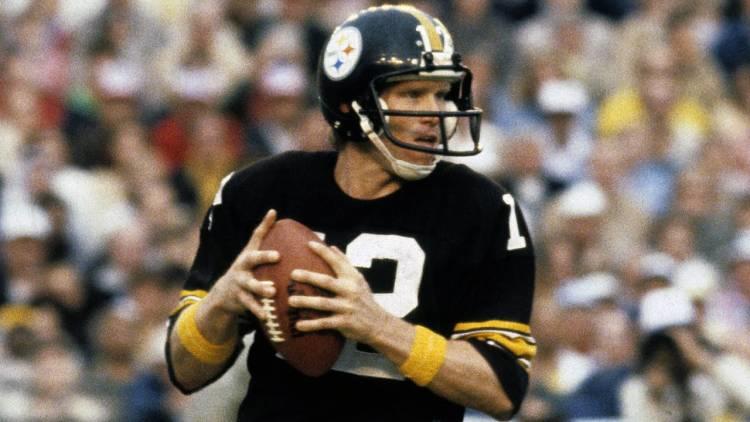
In the 1970 NFL Draft, Terry Bradshaw was selected 1st overall by the Pittsburgh Steelers where he would play his entire fourteen-season NFL career. In his second season with the Steelers, Bradshaw became the starting quarterback and helped the Steelers secure their first-ever championship defeating the Minnesota Vikings in Super Bowl IX. This win sparked a four-title reign within a six-year period as Bradshaw led the Steelers on field as a quarterback and technically an offensive coordinator winning Super Bowls, X, XIII, and XIV all the while being named MVP for his performances in Super Bowls XIII and XIV. Terry Bradshaw became the first quarterback ever to win three and four Super Bowls. Somehow, Bradshaw only was invited to three Pro Bowls (1975, 1978, and 1979) and earned one NFL MVP Award (1978).
Randall Cunningham has to be described as one of the most dynamic quarterbacks to ever take the field. Cunningham had a high-level football IQ with the speed and agility of a wide receiver. Standing at 6'4, Cunningham had the ability to deliver the ball comfortably from almost anywhere on the field. Randall Cunningham's style of play could be considered the blueprint for Michael Vick's approach to the game as well. Hailing from Santa Barbara, California, Randall played his collegiate football at the University of Nevada, Las Vegas initially as a punter for the Rebels being named All-American for the 1983 and 1984 seasons. It wasn't until his senior year that he would take a snap as the UNLV Rebels' starting quarterback leading them to an 11-2 season that was later recalled and adjusted to 0-13 after the discovery of several illegitimate players on the team. Prior to the record adjustment, the 11-2 record led by Cunningham was the first ten-win season in the school's history.
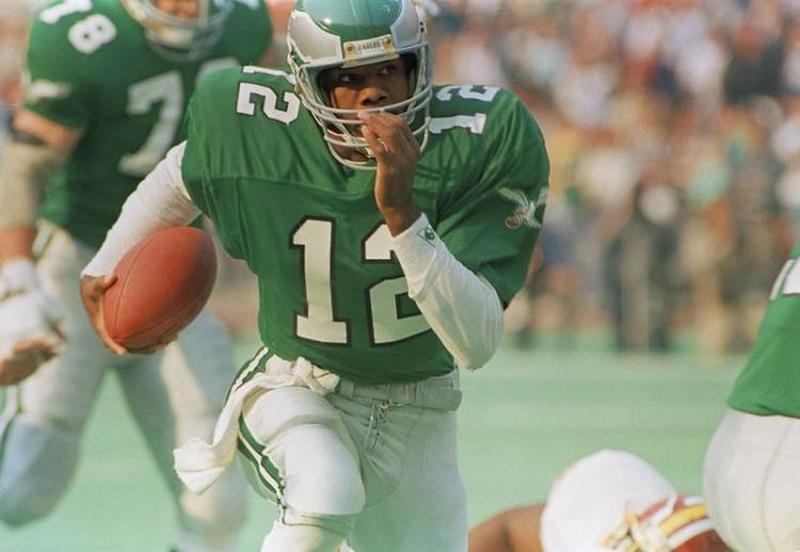
In the 1985 NFL Draft, Randall Cunningham was selected 37th overall in the second round by the Philadelphia Eagles. After being designated as a starter in the midst of the 1986 season, the Eagles disastrous offensive line allowed Cunningham to be sacked a franchise record of 72 times. In eleven seasons with the Eagles, Cunningham became the record holder for rushing yards per attempt (6.62) and the third-place record holder for rushing yards by a quarterback (4,482). After suffering some inconvenient injuries, throughout the mid-'90s and falling to a backup quarterback position, Cunningham retired in 1995 but returned a year later as a member of the Minnesota Vikings. In 1998, Cunningham led the Vikings to a 15-1 record and led the league in passer rating with 106.0 on 34 touchdowns. Unfortunately, the Vikings weren't able to make it to the Super Bowl and Cunningham retired following the 2001 season after two short stints with the Dallas Cowboys and Baltimore Ravens. With a touchdown to interception ratio of 207-134 and four Pro Bowls under his belt, Cunningham is a decorated quarterback but its his style of play that will never be forgotten.
Joe Namath's aura during his prime years were that of a Hollywood personality rather than that of an athlete's. Sex, drugs, and rock 'n roll was the lifestyle for the man nicknamed, Broadway Joe, but while he was the party type who was continuously spotted with a hottie on his arm, he also was a major problem on the football field as well. The three-sport high school athlete known for his dunking ability took his talents to the University of Alabama where he played from 1962 to 1964 and stated that residing in Alabama was a culture shock for him being that he grew up in a predominantly black neighborhood in Pennsylvania. However, that didn't stop Namath from leading the Crimson Tide to a 29-4 record during his three-year tenure in Alabama and a national championship in 1964.
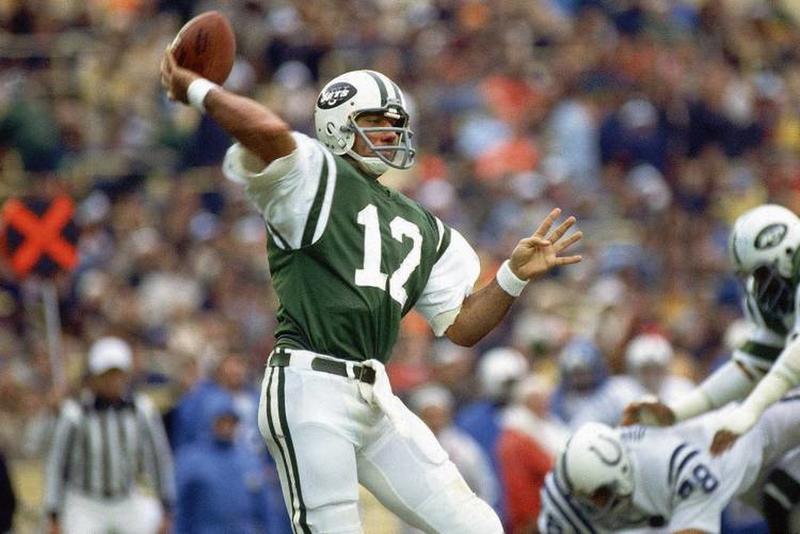
In the 1965 NFL Draft, Joe Namath was selected 12th overall by the St. Louis Cardinals while the New York Jets selected Namath 1st overall in the AFL Draft. After negotiations took place, Namath signed a contract with the New York Jets where he would become a local legend and play all but one out of the thirteen seasons of his professional football career. Despite going winless in his first six games as a rookie, Namath was able to scoop up the award for AFL Rookie of the Year. He would then go on to lead the Jets to an AFL Championship win in 1968 while also being named an AFL All-Star four times and AFL MVP twice. Following the AFL-NFL merger in the mid-'60s, Namath also participated in Super Bowl III against the Baltimore Colts, leading the Jets to a 16-7 victory and winning Super Bowl MVP honors. In 132 starts, Namath ended his football career with an overall record of 64-64-4 and a touchdown to interception ratio of 173-220. While some may argue Namath is mediocre at best skill-wise, his celebrity and impact on football culturally have made him an icon.
Football fans that are extra critical of the Dallas Cowboys tend to assume that the stars just so happened to align during a time the Cowboys were ascending into greatness regardless of who their quarterback was throughout the 1990s. However, despite the Cowboys having Hall of Fame talent like Michael Irvin and Emmitt Smith on their side, Troy Aikman was just as crucial to that team's success as much as any other star was on that Dallas Cowboys' offense. In 1984, Troy Aikman went to the University of Oklahoma to play football despite being contract offers from the New York Mets. Aikman became the first true freshman to start at quarterback for the Sooners since World War II. After suffering a broken ankle in his second season with the Sooners, Aikman transferred to UCLA to finish playing football. As a senior, Aikman won the Davey O'Brien Award and led the Bruins to a victory in the 1989 Cotton Bowl Classic against the Arkansas Razorbacks.
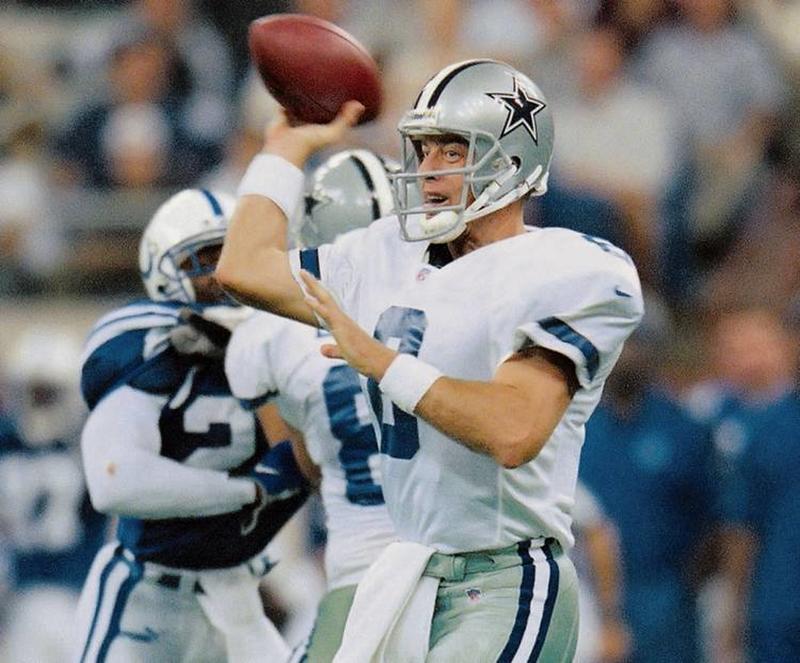
After winning with two prestigious football institutions, Troy Aikman was drafted 1st overall in 1989 NFL Draft by the Dallas Cowboys where he would play his entire twelve-season career. As a starter, Aikman finished his rookie season with a winless record of 0-11, but despite his adversities as a young quarterback, the Cowboys kept faith in Aikman which allowed him to start at the position for all twelve years of his career, the longest streak held by any Dallas Cowboys quarterback. Within those years, Aikman was able to become a 6x Pro Bowler and 3x Super Bowl Champion (XXVII, XXVIII, and XXX). Aikman was named Super Bowl MVP in Super Bowl XXVII for his four touchdown and 273 passing yard performance. Surprisingly, Aikman was never named First-Team All-Pro during his entire NFL career.
Warren Moon might not be the most decorated football player to make this list, but on just pure will and skill alone, Warren Moon is amongst one of the better quarterbacks to ever pick up a football. Not to mention, Moon played a total of twenty-three seasons of football as a professional making his durability and longevity a key component to the success he had has as a high IQ football player who's able to recognize defensive scenes with his eyes closed. The 6'3 quarterback from Los Angeles, California attended a local junior college for two years prior to taking his talents to the University of Washington. In his first two seasons as a starter with the Washington Huskies, Moon ended up with a .500 record of 11-11. However, during his senior season, Warren Moon led the Huskies to a PAC-8 Championship and upset win over the Michigan Wolverines in the 1978 Rose Bowl and was named the game's MVP.
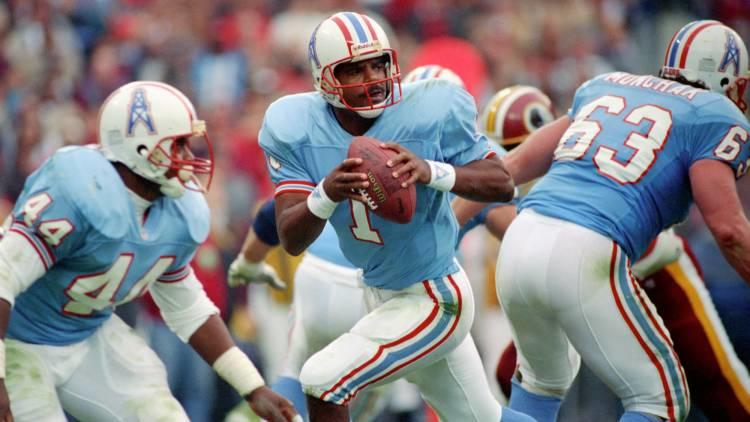
Despite his amazing play in college, Warren Moon went undrafted in the twelve-round 1978 NFL Draft and decided to play for the Canadian Football League's Edmonton Eskimos where he helped lead the franchise to five straight Grey Cup victories (1978-1982) and was named the Grey Cup MVP twice (1980 and 1982). After having so much success in the CFL, Moon took an offer from the NFL's Houston Oilers in 1984 where he would play for the next decade. Warren Moon also played short stints with the likes of Minnesota Vikings, Seattle Seahawks, and Kansas City Chiefs before retiring mid-season in 2001. Throughout his NFL career, Moon threw for over 4,000 yards on four different occasions in a single season. He also threw for nearly 50,000 yards in the NFL alone, if you were to combine Moon's CFL stats with his NFL stats, we'd be staring at one of the most dominant quarterbacks of all-time. While Moon did never win a Super Bowl, he was able go to the Pro Bowl a total of nine times.
When it comes to one of the most prolific passers in the game, look no further than Dan Fouts. Fouts' ability to deliver long distant passes with the precision to hit wideouts right in between the numbers was uncanny during his time in the NFL. The 6'3 quarterback from San Francisco, California was easily one of the best quarterbacks throughout the 1970s and '80s. Despite not really making a buzz from recruiters, Fouts accepted a scholarship offer from the University of Oregon where he played from 1970 to 1972. In just three seasons with the Ducks, Fouts was able to break a total of nineteen school records including career passing yardage (5,995).
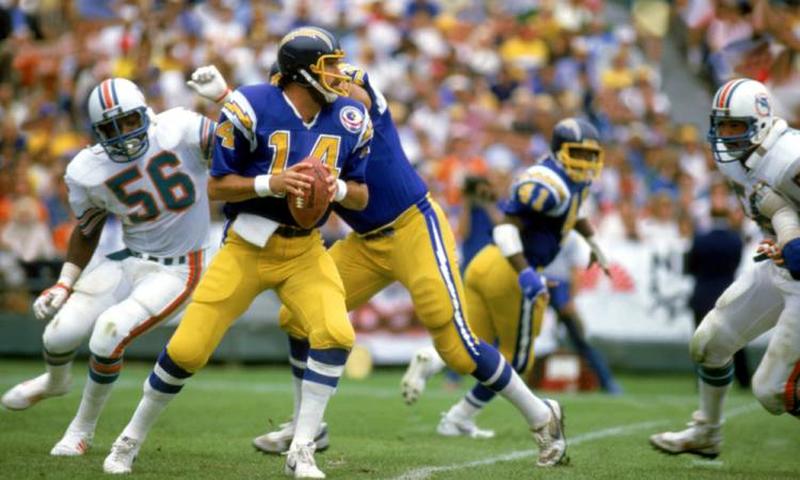
After coming off of a successful college football career, Dan Fouts was drafted 64th overall in the third round of the 1973 NFL Draft by the San Diego Chargers where he would play his entire professional career. Fouts would go on to lead the San Diego Chargers to playoff berths for four consecutive seasons (1979-1982) and two AFC Championship games (1980 and 1981) but never made a single Super Bowl appearance. However, the 6x Pro Bowler did rack up a ton of impressive individual feats including leading the NFL in passing yards for four seasons straight (1979-82) and becoming the first quarterback to throw for over 4,000 yards in three consecutive seasons (1979-1981). After the 1987 season, Fouts hung up his cleats for good and now resides in Sisters, Oregon.
Roger Staubach's name flies under the radar when it comes to speaking on the greatest quarterbacks of all-time. Yet, Staubach was a crucial contributor to "America's Team's" success throughout the '70s. While his tenure in the NFL was considerably short, he left a lasting impact on the league and the Dallas Cowboys organization that will be memorialized forever. Hailing from Cincinnati, Ohio Staubach played his college football at the United States Naval Academy from 1962 to 1964. In at quarterback for the very first time, Staubach was sacked twice and went 0-2 for -24 yards. However, Hall of Fame coach, Wayne Hardin, kept his faith and continued to play Staubach who eventually won the Heisman Trophy, the Maxwell Award, and the Walter Camp Memorial Trophy his junior year after leading the Navy Midshipmen to a 9-1 record in 1963. Following his tenure at the Academy, Staubach joined the military and even did a tour in Vietnam.
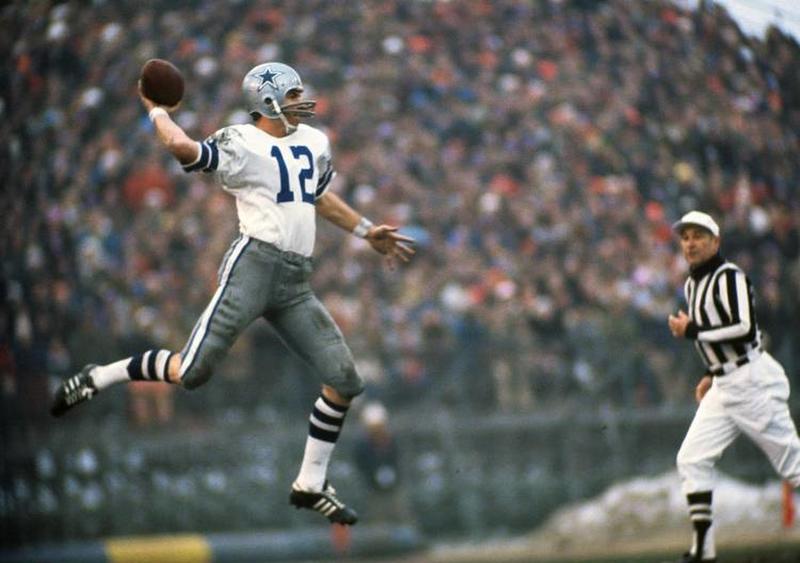
Roger Staubach was selected 129th overall in the tenth round of the 1964 NFL Draft by the Dallas Cowboys as a 'future' pick due to Staubach's military commitment. Staubach wouldn't play a single snap of professional football until the age of 27-years-old. Staubach wouldn't become the Cowboys starting quarterback until 1971 where he would lead the Texas-based football franchise to their first-ever Super Bowl victory in Super Bowl VI against the Miami Dolphins also winning Super Bowl MVP honors for his performance as well. After suffering a severe shoulder injury and missing most of the 1972 season, Staubach would return and lead the Cowboys to three more Super Bowl appearances (X, XII, and XIII). While the Cowboys lost both Super Bowls X and XIII to the Pittsburgh Steelers, Staubach was able to help his team secure a second ring at Super Bowl XII. After eleven seasons in the NFL, Staubach retired a Cowboys legend in 1980.
Bart Starr's football career is reminiscent of something out of a classic sports movie. Starr led his team to the highest plateaus and succeeded at the highest level during an era of football that began every football player's lust for the Lombardi Trophy. Unfortunately, Starr passed away earlier this year due to health complications from a stroke he suffered back in 2014. While his physical form is no longer with us, he will forever be remembered for his impact on the field from fans and for his love as a father and husband by his loved ones. Starr played his collegiate football at the University of Alabama where he played the quarterback, safety, and punter positions and led the Crimson Tide to the 1953 Cotton Bowl. Unfortunately, Starr suffered a severe back injury from a hazing incident and the rest of his college football career remained uneventful.
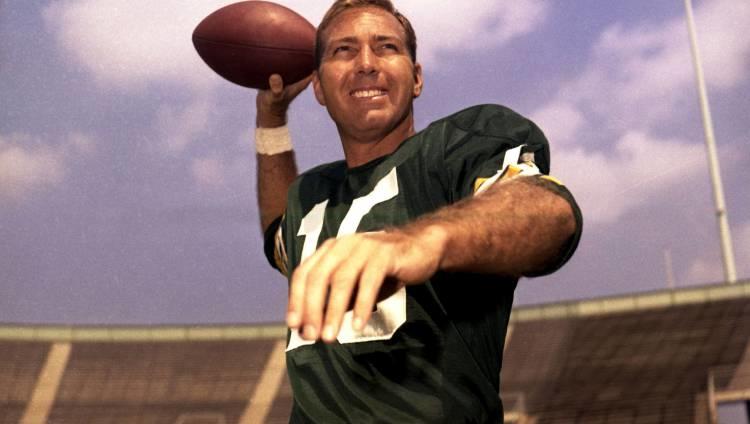
In the 1956 NFL Draft, Bart Starr was selected 200th overall in the seventeenth round by the Green Bay Packers where he would play his entire sixteen-season NFL career. It wasn't until 1959 that Starr won the starting quarterback position thanks to then-new head coach, Vince Lombardi. As a starter, Starr would go on to lead the Packers to five NFL Championships including winning three consecutive championships from 1965 to 1967. The Packers were the only team to ever win three consecutive championships since the induction of the playoff system in 1933. Starr also led the Packers to championship wins in both Super Bowl I and II. In 1971, Starr retired with the second-best career passer rating at the time of 80.5.
Hailing from Chico, California is current NFL quarterback for the Green Bay Packers, Aaron Rodgers next on the list. What Aaron Rodgers has been able to accomplish over the past decade and a half has been nothing short of simply amazing. No matter the situation he and his team may find themselves in, Rodgers has the poise and leadership qualities to steer his team in the right direction towards success. Prior to playing for the California Golden Bears, Rodgers played at Butte Community College for the 2002 season. In two seasons at the University of California, Berkeley, Aaron Rodgers finished his career with an insane passer rating of 150.27, 17-4 overall record, and 2003 Insight Bowl MVP honors.
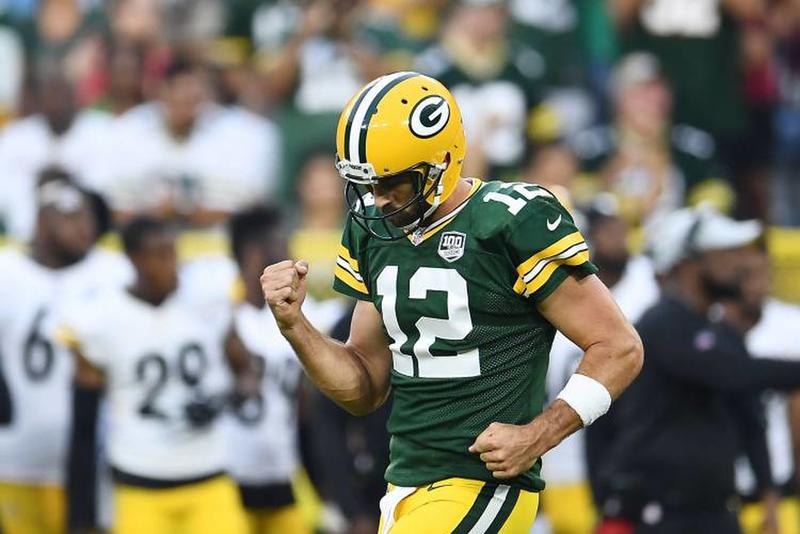
In the 2005 NFL Draft, Aaron Rodgers was selected 24th overall by the Green Bay Packers. For his first three seasons, Rodgers would rarely see the field, however, when starting quarterback and Packers legend Brett Favre announced his retirement in January 2008, Rodgers knew it was his time to step up and lead the Packers back to the glory land. In twelve seasons as a starter, Aaron Rodgers has raked in two NFL MVP honors (2011 and 2014) and helped the Packers win a championship in Super Bowl XLV against the Pittsburgh Steelers where he was also named Super Bowl MVP. After leading the NFL in touchdown to interception ratio four times, Rodgers currently holds the NFL all-time regular-season record for career passer rating and is one of two quarterbacks in history to have a passer rating of over 100 in a single season. With gas still left in his tank, Rodgers has the opportunity to continue building his case for best quarterback of all-time.
Here's a name that doesn't get brought up enough when it comes to talking about who can slang the rock the best, Fran Tarkenton. Yes, Francis Asbury Tarkenton. What he was doing throughout the '70s is reminiscent of what a lot of quarterbacks are achieving today. Tarkenton was ahead of his time in regards to his style of play, accuracy, and willingness to make daring passes that always appeared to be right on target. After going to high school in Athens, Georgia and growing up a Bulldogs fan, Tarkenton got to live out a childhood dream of playing quarterback for the institution helping the Bulldogs secure a Southeastern Conference Championship while picking up two First-Team All-SEC honors.
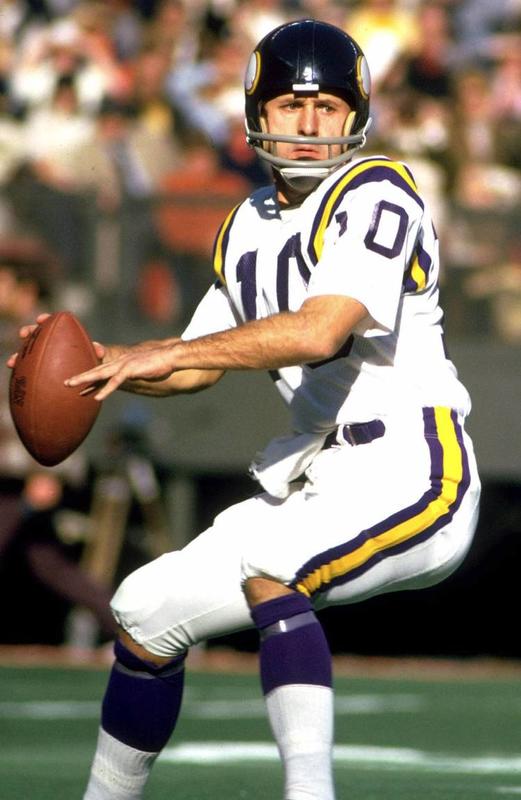
After an impressive showing at the University of Georgia, Fran Tarkenton was selected 29th overall in the third round of the NFL Draft by the Minnesota Vikings and 34th overall in the fifth round of the AFL Draft by the Boston Patriots. Tarkenton decided to sign with the Vikings rather than the Patriots and became an instant impact player coming off the bench in his first game for a come-from-behind 37-13 victory over the Bears throwing 250 yards for four touchdowns. While Tarkenton became notorious for his insane stat lines, his team struggled as a brand new franchise only winning a total of ten games in his first three seasons with the Vikings. Tarkenton spent a brief tenure with the New York Giants from 1967-1972 before being traded back to the Vikings to finish out his career in 1979. While he was unable to win a championship, Tarkenton owned every major quarterback record by the time he retired, was a 9x Pro Bowler and took home, the NFL MVP Award in 1975.
A lot of the youngsters reading the name Otto Graham so high up on the list are probably scratching their heads right now and that's ok. Otto Graham played during an era of football where proper head protection was inadequate and the shoulder pad technology wasn't the greatest. However, that didn't stop Graham from being one of the most dominant athletes in professional football throughout the 1940s and '50s. The 6'1 quarterback from Waukegan, Illinois attend Northwestern University of a basketball scholarship but also played football for the private college as well from 1941 to 1943. While in school, the attack on Pearl Harbor occurred and Graham signed up for the United States Coast Guard all the while setting a single-season Big Ten Conference record for completions with 89 in 1942. Prior to playing professional football, Graham also played pro basketball as a member of the Rochester Royals in the National Basketball League (NBL).
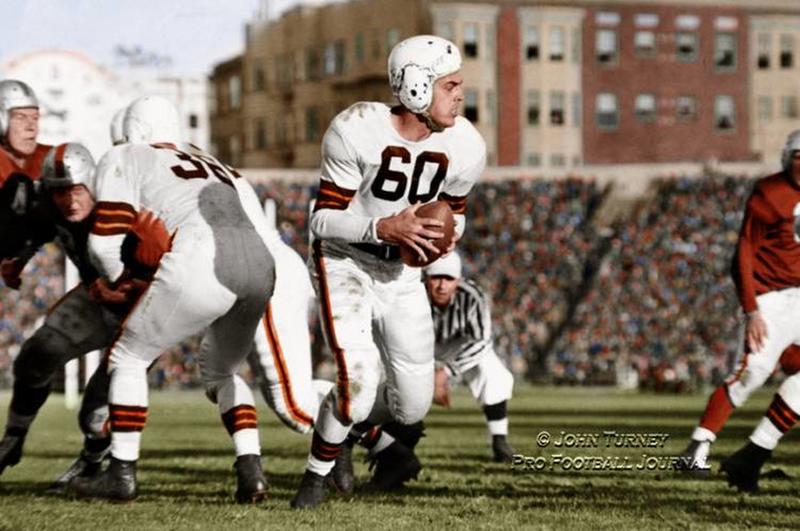
After being discharged by the Navy in 1946, Otto Graham reported to the Cleveland Browns training camp. In his first season as a starter, Graham led the Browns to a 12-2 record and defeated the New York Yankees in the AAFC Championship. From 1946 to 1949, Graham and the Browns won four consecutive AAFC Championships and even went undefeated in the 1948 season. After the AAFC dissolved in 1949, the Cleveland Browns merged into the NFL and played their first season in the league in 1950. Instantaneously, the Browns came into the league and won their first championship against the Los Angeles Rams. Graham would lead the Browns to three more consecutive championship games but wouldn't another until 1954 and 1955. The 6x Pro Bowler and 3x NFL MVP (1951, 1953, and 1955) called it quits on the game after the 1955 season. Otto Graham passed away at the age of 82 in September 2003, he will always be remembered for dominating the game during his time as a pro football player.
Johnny Unitas is arguably responsible for professional football being as popular as it is today. Prior to the media spectacle that was Johnny Unitas there rarely was a quarterback that garnered the attention of a celebrity like Unitas did. On top of his drawing personality, Unitas was also the quintessential blueprint for the modern-day quarterback, his pocket precision, laser for an arm, and ability to read defenses caused trouble for many defensive coordinators and game planners. The Pittsburgh-bred athlete attended the University of Louisville from 1951 to 1954. Despite only weighing 145lbs during his freshman season, Unitas led the Cardinals to a 5-5 record as a freshman. After the university de-emphasized sports and Unitas was forced to take a square dancing class an elective, the Cardinals went 7-18 during Unitas' tenure with the team.
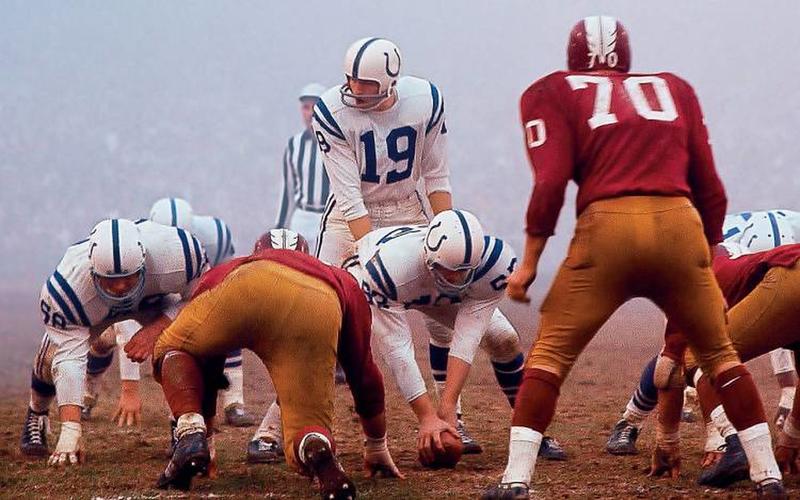
Despite Unitas lackluster collegiate football career, he was selected 102nd overall in the ninth round of the 1955 NFL Draft by the Pittsburgh Steelers but was cut from the team before the season started. In 1956, Johnny Unitas joined the Baltimore Colts where in his NFL debut he went 0-2 and threw one interception. It wasn't until 1957, Unitas picked up steam throwing an NFL-high 2,550 yards for 24 touchdowns. After establishing his confidence, Unitas led the Baltimore Colts to three NFL Championships (1958, 1959, and 1968), a Super Bowl victory (Super Bowl V), became a 10x Pro Bowler, and 3x NFL MVP. Unitas led the league in passing touchdowns for four consecutive seasons (1957-1960) and held the record for most consecutive games with a passing touchdown for 52 years before Drew Brees broke it in 2012. Sadly, Johnny Unitas passed away at just 69-years-old in September 2002 after suffering a heart attack. Never to be forgotten and always remembered, Johnny U.
They said he was too short, his hands were too small, lacked pocket presence, and would never be an effective NFL quarterback, and boy, did he prove the masses wrong. Drew Brees is one of the most unorthodox quarterbacks of this current generation of play-callers. While he is primarily a pocket-passing quarterback he tends to slide outside the pocket for better vision outside of his linemen. After receiving only two scholarship offers, the 6'0 quarterback hailing from Dallas Texas played his college ball in Indiana at Purdue University. In four seasons with the Boilermakers, Brees shattered two NCAA records, thirteen Big Ten Conference records, and nineteen Purdue University football records. As a senior, Brees led Purdue to their first Big Ten Championship title since 1967.
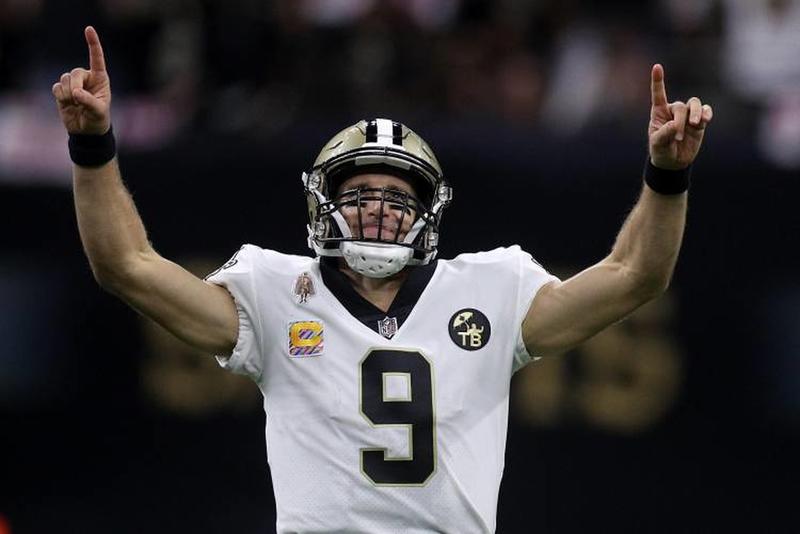
Despite his sensational play at the collegiate level, Drew Brees was selected 32nd overall in 2001 NFL Draft by the San Diego Chargers. In five seasons with the Chargers, Brees was able to lead the team to one playoff berth in 2004. Unfortunately, after severely injuring his right shoulder, he lost his starting quarterback job to Philip Rivers and signed a contract with the New Orleans Saints free agent in 2006. This is where the legend of Drew Brees officially began. Since joining the Saints, Brees has led the Saints to seven playoff runs in fourteen seasons. In 2009, Brees tied the Super Bowl completions record (32) on route to a 31-17 victory over the Indianapolis Colts. Brees was named Super Bowl MVP and currently holds NFL records for career pass completions passing yards, completion percentage, touchdown passes, and more. The funny thing about Drew Brees is that his story is nowhere near over as the Saints look to b preparing for yet another postseason run.
Not every NFL scout has the eye to recognize all-time talent and Steve Young's rise to prominence is the perfect example of talent that got away from many football franchises. On the field, Young was a risk-taker and was willing to take the blame for some of the wild throws he would take. But while he knew some of the attempts he was making were irresponsible, he was also aware that some of those passes would ingrain his name as an NFL legend. While at Bringham Young University, the coaching staff considered switching Young to defensive back because of his athletic ability and the struggles he was having getting accumulated as a college quarterback. But after countless hours of work, Young proved he was worthy of the position and set an NCAA single-season record with a completion percentage of 73.1 as a senior in 1983. Young also helped BYU set an NCAA record averaging 584.2 yards per game as well. To close out his college career Young led the Cougars to a 21-17 victory in the 1983 Holiday Bowl against the Missouri Tigers.
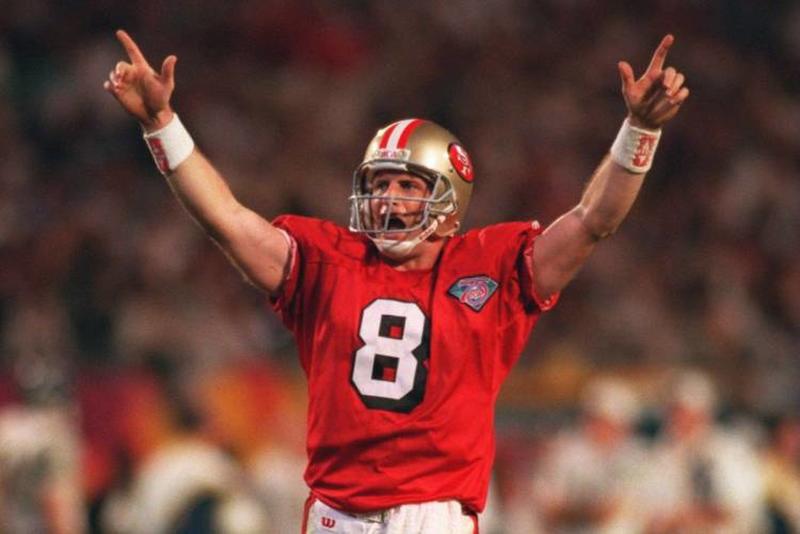
Prior to entering the NFL, Steve Young played in the United States Football League (USFL) with the Los Angeles Express for two seasons before the league was dissolved. Young was picked by the Tampa Bay Buccaneers in the supplemental draft but went 3-16 with Young as a starter. In 1987, Steve Young was traded to the San Francisco 49ers where he would make history leading the team to three Super Bowl victories (XXIII, XXIV, and XXIX). Young would win Super Bowl MVP honors in Super Bowl XXIX for throwing a Super Bowl record six touchdowns against the San Diego Chargers. Young had a passer rating of over 100 six times throughout his fifteen-season NFL career along with seven Pro Bowl nods and two NFL MVP honors. Steve Young retired following the 1999 NFL season.
John Elway was one of the most highly-intelligent gun-slingers in the entire NFL during his era in the league. His work ethic and willingness to go the extra mile is why he's one of the greatest quarterbacks to ever hit the field. What many tend to forget about Elway due to his immaculate passing ability is that he was an amazing rusher for his 6'3, 215lb frame. Hailing from Port Angeles, Washington, John Elway enrolled at Stanford University where he would go on to set several career records for the school including passing attempts and completions. Elway also excelled at baseball being drafted by the New York Yankees in 1981 MLB Draft. However, Elway would go on to set nearly every passing record for the Pac-10 Division and graduate with a bachelor's degree in economics after going 20-23 as a Stanford Cardinal.
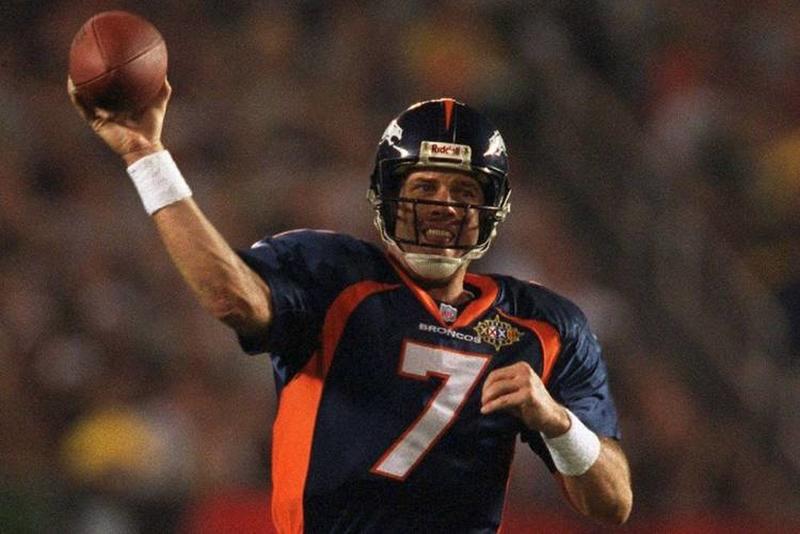
Despite not leading his college team to a single bowl game, John Elway was drafted 1st overall in the 1983 NFL Draft by the Baltimore Colts. Elway caused a lot of controversy when he refused to suit for the Colts and finagled his way onto the Denver Broncos roster. Three years later, Elway would lead the Broncos to Super Bowl XXI against the New York Giants but fall short of winning the championship. In 1997, Elway helped the Broncos win their first-ever championship in Super Bowl XXXII, the following season Elway led the Broncos to their second title defeating the Atlanta Falcons 34-19 in Super Bowl XXXIII which was his final game in the NFL. The 9x Pro Bowler and 1x NFL MVP Award-winner is the only quarterback to have a rushing quarterback in four different Super Bowls. Prior to the arrival of Tom Brady, Elway held the record for Super Bowl quarterback starts with a total of five.
Daniel Constantine Marino Jr. is one of those quarterbacks that should be more decorated than they are. His ability to get the ball out his hands in less than a blink of an eye made him nearly unstoppable from behind center. With a laser for an arm and ability to throw the ball fifty-plus yards down the field off of the wrong leg made the fact that he was a less than adequate scrambler a non-factor. Dan Marino attended the University of Pittsburgh from 1979 to 1982 where he boosted the team's rankings within the top five throughout the four seasons he played for the Panthers. His first three seasons as a Panther, Marino led the team to a 33-3 record but unfortunately during his senior year, Marino's statistics took a drastic dip but led the team to the 1983 Cotton Bowl Classic where they lost 7-3 to Southern Methodist University. However, Marino did finish college career with 7,905 passing yards and 74 touchdowns.
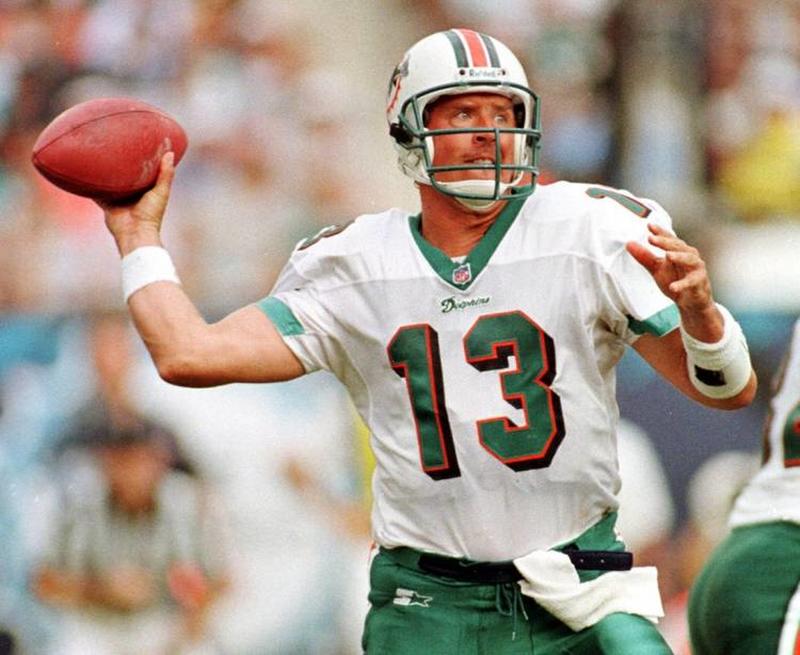
After a dip in his play in his final season with the Pittsburgh Panthers, Marino was selected 27th overall in the 1983 NFL Draft by the Miami Dolphins. Despite being the last quarterback picked in the first round of the draft, Marino set several NFL records as a rookie including a 96.0 passer rating, the highest completion percentage that season with 58.45 percent, and the lowest interception percentage with 2.03%. Marino played his entire pro football career with the Dolphins leading the team to the postseason ten times, reaching the Super Bowl one time (Super Bowl XIX), and winning the NFL MVP award in 1984. By the time of his retirement in 2000, Marino had held over 40 single-season and career passing NFL records. Most of which have been broken. Dan Marino is considered the greatest quarterback of all-time to have never won a Super Bowl. Still to this day, many try to emulate his style of play on the field.
Brett Favre has never seen a football that he wasn't willing to throw in the midst of any defense. Favre was relentlessly brave when it came to dropping back and letting it fly downfield. So much that Favre holds the NFL record for most career interceptions. While that might appear negative mark on his legacy, Favre also is one of the most successful and studied quarterbacks of all-time. The 6'2 quarterback hailing from Gulfport, Mississippi accepted a scholarship offer to play in his home state at the University of Southern Mississippi. Originally, the coaching staff pressured Favre to play defensive back but proved he was worth the starting quarterback position after being labeled as the seventh-string quarterback. In four seasons as a Southern Miss Golden Eagle, Favre shattered most of the team's quarterback records with a total of 7,695 passing yards, 52 touchdowns, and an overall quarterback rating of 116.6.
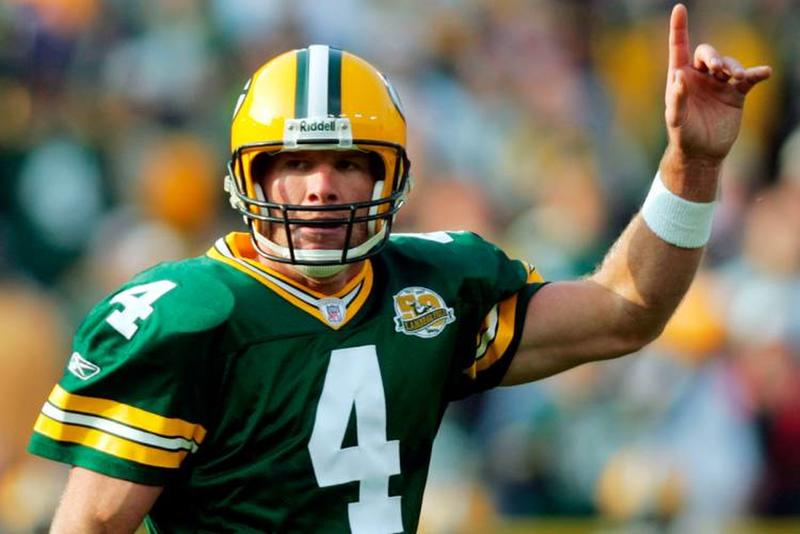
Despite having a legendary collegiate football career, Favre was selected 33rd overall in the second round of the 1991 NFL Draft by the Atlanta Falcons. In a single season with Atlanta, Favre only took four pass attempts, two of which were intercepted. The following season, Favre made his way to the Green Bay Packers where he would play his best football for the next decade in a half. In the 1993 season, Favre led the Packers to their first postseason since 1982. After becoming the main play-caller, Favre led the Packers to a total of eleven playoff berths, eight division championships, five NFC Championship games, and two Super Bowl appearances (XXXI and XXXII). The 11x Pro Bowler led the Packers to a championship over the New England Patriots in Super Bowl XXXI. Favre also is the only player to have won three straight MVPs (1995-1997) and held the all-time leading records for passing yards, passing touchdowns, and quarterback wins upon his retirement in January 2011. Those records have since then been broken but Favre will forever be known as one of the blueprints for the modern-day quarterback.
Joe Montana's biography is something out of an unrealistic, cheesy sports movie. Young Montana grew up in a blue-collar, rugged coal mining city with big dreams of making it big in sports one day. Young Montana goes off to college where he becomes extremely successful than off to the pros to become an undefeated champion wreaking havoc on whoever got into his way. While this may sound unbelievable and somewhat far-fetched, it's 100% true and he's undeniably one of the best players to ever strap up their pads and pick up a football. Hailing from New Eagle, Pennsylvania, Joe Montana AKA 'The Comeback Kid' played his collegiate football at the University of Notre Dame from 1974 to 1978. Montana wouldn't see any major playing time until his sophomore season but would eventually lead the prestigious football program to two Cotton Bowl victories in 1977 and 1978.
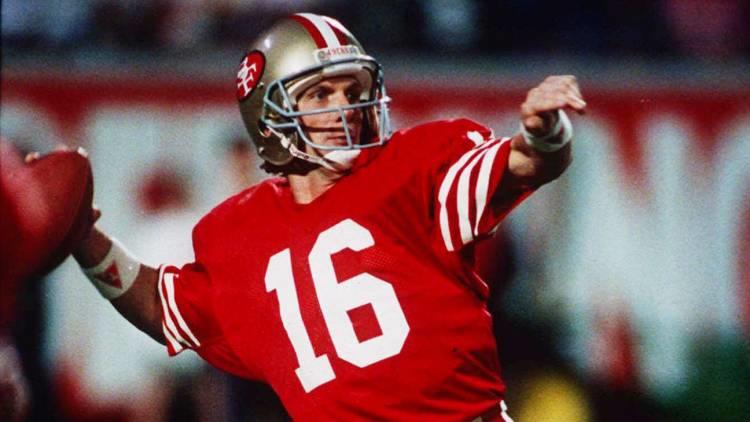
Somehow in the 1979 NFL Draft, Joe Montana was selected 82nd overall in the third round by the San Francisco 49ers where he would play fourteen out of the sixteen seasons of his NFL career. As a rookie, Montana played in all sixteen regular-season NBA games but only attempted twenty-three passes. It wasn't until the 1980 season, Montana would become the team's official starting quarterback and he would begin his reign of terror on the entire league. Montana would lead the Niners to the playoffs a total of nine times, making four Super Bowl appearances and winning every single one (XVI, XIX, XXIII, and XXIV). Montana was the first player ever to win three Super Bowl MVP honors (XVI, XIX, and XXIV). The Comeback Kid currently holds Super Bowl records for most pass attempts without an interception (122) and all-time highest passer rating (127.8). Montana played his final two NFL seasons with the Kansas City Chiefs and led the team to its first-ever AFC Championship game in 1994 before officially retiring.
Peyton Manning is one of the most calculated and diabolical field generals to ever hit the football field. His ability to read a defense flawlessly and audible at the line of scrimmage a plethora of times to ensure he makes the right decision with the football is one of the most impressive sights to see as an analytical admirer of the sport. Not to mention his precision and arm strength are uncanny assets to his already genius football mind. The son of the famed ex-quarterback and brother of Eli Manning played his college football at the University of Tennessee from 1994 to 1997. During his four-year tenure with the Tennessee Volunteers, Manning ended his career with a quarterback rating of 147.1 while throwing a total of 11,201 yards, and 89 touchdowns. In his senior with the team, Manning led the Volunteers to a comeback 30-29 win over Auburn in the SEC Championship game.
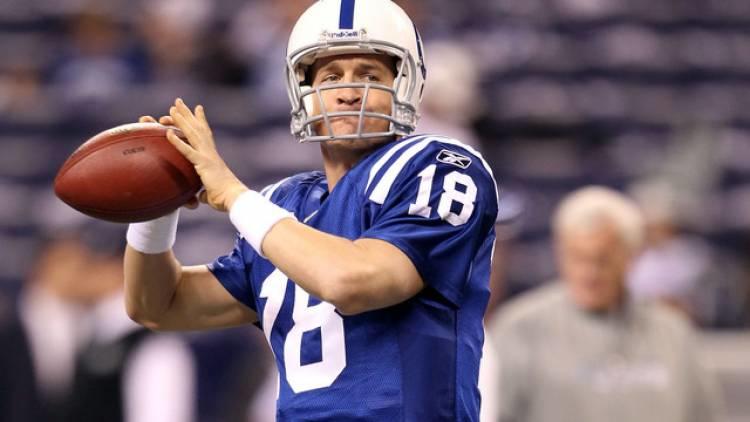
Following his historic college football career, Peyton Manning was selected 1st overall in the 1998 NFL Draft by the Indianapolis Colts. As a. member of the Colts for fourteen seasons, Manning threw for over 4,000 yards a total of ten seasons and led the league in passer rating for three consecutive seasons from 2004 to 2006. In 2006, Manning led the Colts to a Super Bowl victory over the Chicago Bears in Super Bowl XLI and was awarded Super Bowl MVP honors for his 247 passing yards and one touchdown performance. After missing the entire 2011 season due to a neck injury, Manning took his talents to Denver and led them to a championship, winning Super Bowl 50 over the Carolina Panthers. The 14x Pro Bowler currently holds NFL records for most touchdown passes (539), AP MVP Awards (5), Pro Bowl appearances (14), 4,000-yard passing seasons (14), and more. After winning Super Bowl 50 in 2015, Manning gracefully bowed out of the game for good.
Number one on our greatest quarterbacks of all-time list goes to none other than Tomas Edward Patrick Brady Jr. Not only has Tom Brady had the gift of health and longevity, he's remained extremely skilled throughout his twenty-season NFL career and still has the potential to play for an additional three years. Sometimes, the stars align for people, not to discredit the work that Brady has done but he's been placed in a system and situation that has allowed him to thrive for the past two decades. Prior to becoming the best professional quarterback of all-time, Tom Brady played college football at the University of Michigan from 1995 to 1999. Brady saw few snaps his first two seasons as a back up for Brian Griese but as a full-time starter, he instantly made an impact setting a record for most completions in a single season with 214. The Michigan Wolverines won a total of twenty games out of the twenty-five Brady started for the team and led them to victories in the 1999 Citrus Bowl and 2000 Orange Bowl.

After lighting up the field at Michigan, Tom Brady was surprisingly selected 199th overall in the sixth round of the 2000 NFL Draft by the New England Patriots where he's played his entire career. It wasn't until the decline of Drew Bledsoe that Tom Brady would become the team's starting quarterback in 2001. Since Brady's takeover, the Patriots have never had a losing record, have participated in a total of thirteen AFC Championship games, made nine Super Bowl appearances winning six (XXXVI, XXXVIII, XXXIX, XLIX, LI, and LIII) making Brady the most-winningest quarterback in NFL history. Brady also holds the NFL record for most Super Bowl MVP Awards with four (XXXVI, XXXVIII, XLIX, and LI) and division titles with sixteen. With over 200 regular-season wins and a 30-10 postseason record, Tom Brady also has the most playoff wins of any player ever to take the field. At the age of 42 and still with some gas left in the tank, Brady has the opportunity to continue smashing the record books making him not only the greatest quarterback of all-time but possibly the best football player of all-time as well.